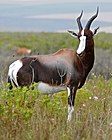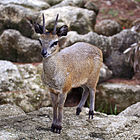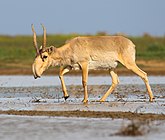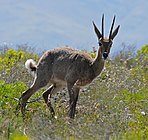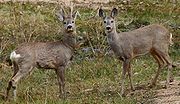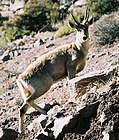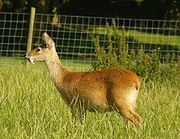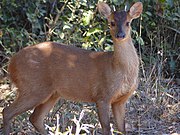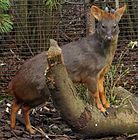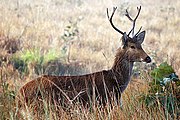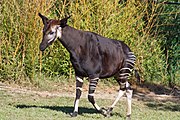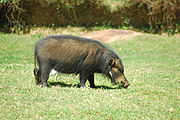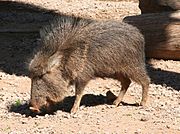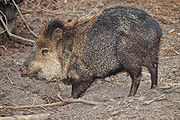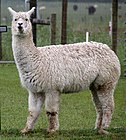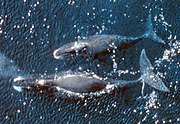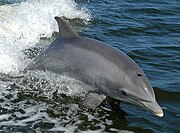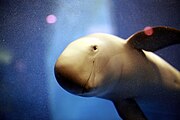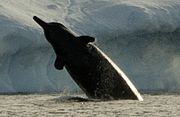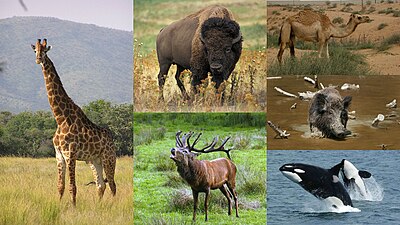
Artiodactyla is an order of placental mammals composed of even-toed ungulates – hooved animals which bear weight equally on two of their five toes with the other toes either present, absent, vestigial, or pointing posteriorly – as well as their descendants, the aquatic cetaceans. Members of this order are called artiodactyls. The order is sometimes named Cetartiodactyla, in reference to the inclusion of cetaceans in the order beginning in the 1990s. Artiodactyla currently comprises 349 extant species, which are grouped into 132 genera. Artiodactyls live on every major landmass and throughout the oceans and in a variety of habitats, including forests, grasslands, and deserts. They come in a wide array of body plans in contrasting shapes and sizes, ranging from the 38 cm (15 in) long and 2.5 kg (5.5 lb) royal antelope to the 27 m (89 ft) long and 120 ton blue whale. Some artiodactyls, such as cattle, goats, sheep, pigs, water buffalo, camels, and llamas, have been domesticated, resulting in a worldwide distribution and population sizes for some animals of over one billion.
Artiodactyla is divided into four suborders: Ruminantia, Suina, Tylopoda, and Whippomorpha. The suborders are further subdivided into clades and families. Ruminantia contains six families, Antilocapridae, Bovidae, Cervidae, Giraffidae, Moschidae, and Tragulidae, and includes ruminant animals such as cattle, antelope, deer, and sheep. Suina contains two, Suidae and Tayassuidae, and includes pigs and peccaries; Tylopoda comprises only Camelidae, the camels and llamas; and Whippomorpha contains fourteen, Balaenidae, Balaenopteridae, Cetotheriidae, Delphinidae, Iniidae, Kogiidae, Lipotidae, Monodontidae, Phocoenidae, Physeteridae, Platanistidae, Pontoporiidae, Ziphiidae, and Hippopotamidae, and includes the aquatic whales and dolphins as well as hippopotamuses. The exact organization of the species is not fixed, with many recent proposals made based on molecular phylogenetic analysis. Three species have gone extinct since 1500 CE: the aurochs and the bluebuck in Bovidae and Schomburgk's deer in Cervidae. Additionally, the red gazelle in Bovidae is considered either extinct or to have never existed; the kouprey in Bovidae is potentially extinct, with no sightings since 1969; and so is the baiji in Lipotidae, last seen in 2002. Several other species are extinct in the wild or critically endangered.
Conventions
Range maps are provided wherever possible; if a range map is not available, a description of the collective range of species in that genera is provided. Ranges are based on the International Union for Conservation of Nature (IUCN) Red List of Threatened Species unless otherwise noted. All extinct genera or species listed alongside extant species went extinct after 1500 CE, and are indicated by a dagger symbol "†".
Classification
The order Artiodactyla consists of 349 extant species belonging to 132 genera. This does not include hybrid species or extinct prehistoric species. Modern molecular studies indicate that the 132 genera can be grouped into 23 families; these families are grouped into named suborders and many are further grouped into named clades, and some of these families are subdivided into named subfamilies.
Suborder Ruminantia
- Infraorder Pecora
- Family Antilocapridae (pronghorn): 1 genus, 1 species
- Family Bovidae
- Subfamily Aepycerotinae (impala): 1 genus, 1 species
- Subfamily Alcelaphinae (wildebeest, hartebeest, bonteboks): 4 genera, 6 species
- Subfamily Antilopinae (antelope, gazelles): 15 genera, 37 species
- Subfamily Bovinae (cattle, buffalos, bison): 9 genera, 30 species (1 extinct)
- Subfamily Caprinae (goats, sheep, ibex, serows): 14 genera, 35 species
- Subfamily Cephalophinae (duikers): 3 genera, 20 species
- Subfamily Hippotraginae (addax, oryx): 3 genera, 8 species (1 extinct)
- Subfamily Nesotraginae (dwarf antelope): 1 genus, 2 species
- Subfamily Reduncinae (reedbuck and kob antelope): 3 genera, 9 species
- Family Cervidae (deer)
- Subfamily Capreolinae (New World deer): 10 genera, 23 species
- Subfamily Cervinae (Old World deer): 9 genera, 32 species (1 extinct)
- Family Giraffidae (okapi and giraffes): 2 genera, 5 species
- Family Moschidae (musk deer): 1 genus, 7 species
- Infraorder Tragulina
- Family Tragulidae (chevrotains): 3 genera, 10 species
Suborder Suina
- Family Suidae (pigs): 6 genera, 17 species
- Family Tayassuidae (peccaries): 3 genera, 3 species
Suborder Tylopoda
- Family Camelidae (camels and llamas): 2 genera, 7 species
Suborder Whippomorpha
- Infraorder Cetacea
- Parvorder Mysticeti (baleen whales)
- Family Balaenidae (right whales): 2 genera, 4 species
- Family Balaenopteridae (rorquals): 3 genera, 11 species
- Family Cetotheriidae (pygmy right whale): 1 genus, 1 species
- Parvorder Odontoceti (toothed whales)
- Family Delphinidae (oceanic dolphins)
- Subfamily Delphininae (dolphins): 6 genera, 15 species
- Subfamily Lissodelphininae (smooth dolphins): 2 genera, 6 species
- Subfamily Globicephalinae (round-headed whales)
- Subfamily Orcininae (killer whale): 7 genera, 9 species
- Subfamily incertae sedis (white-beaked dolphin and Atlantic white-sided dolphin): 1 genera, 6 species
- Family Iniidae (Amazonian river dolphins): 1 genus, 4 species
- Family Kogiidae (dwarf and pygmy sperm whales): 1 genus, 2 species
- Family Lipotidae (Chinese river dolphins): 1 genus, 1 species
- Family Monodontidae (narwhal and beluga): 2 genera, 2 species
- Family Phocoenidae (porpoises): 3 genera, 8 species
- Family Physeteridae (sperm whale): 1 genus, 1 species
- Family Platanistidae (South Asian river dolphins): 1 genus, 2 species
- Family Pontoporiidae (brackish river dolphins): 1 genus, 1 species
- Family Ziphiidae (beaked whales)
- Subfamily Berardiinae (four-toothed whales): 1 genus, 3 species
- Subfamily Hyperoodontinae (bottlenose whales and mesoplodont whales): 3 genera, 18 species
- Subfamily Ziphiinae (Cuvier's beaked whale and Shepherd's beaked whale): 2 genera, 2 species
- Family Delphinidae (oceanic dolphins)
- Parvorder Mysticeti (baleen whales)
- Family Hippopotamidae (hippopotamuses): 2 genera, 2 species
|
Artiodactyls
The following classification is based on the taxonomy described by Mammal Species of the World (2005), with augmentation by generally accepted proposals made since using molecular phylogenetic analysis.
Suborder Ruminantia
Infraorder Pecora
Family Antilocapridae
Members of the Antilocapridae family are called antilocaprids; the family is composed of a single extant species, the pronghorn.
| Name | Authority and species | Range | Size and ecology |
|---|---|---|---|
| Antilocapra | Ord, 1818
One species
|
Western North America (former range in yellow)
|
Size: 130–140 cm (51–55 in) long, plus 9–11 cm (4–4 in) tail Habitats: Shrubland, grassland, and desert Diet: Shrubs and forbs, as well as grass |
Family Bovidae
Main article: List of bovidsMembers of the Bovidae family are bovids and include sheep, cattle, goats, antelope, and others. Bovidae comprises 144 extant species, divided into 52 genera. These genera are grouped into eight subfamilies: Aepycerotinae, or the impala; Alcelaphinae, containing the bontebok, hartebeest, wildebeest, and relatives; Antilopinae, containing several antelope, gazelles, and relatives; Bovinae, containing cattle, buffalos, bison, and other antelopes; Caprinae, containing goats, sheep, ibex, serows and relatives; Cephalophinae, or duikers; Hippotraginae, containing the addax, oryx, and relatives; and Reduncinae, or reedbuck and kob antelopes.
| Name | Authority and species | Range | Size and ecology |
|---|---|---|---|
| Aepyceros | Sundevall, 1847
One species
|
Southern Africa (Common impala in green)
|
Size: 120–160 cm (47–63 in) long, plus 30–45 cm (12–18 in) tail Habitats: Savanna, shrubland, and grassland Diet: Grass and shrubs |
| Name | Authority and species | Range | Size and ecology |
|---|---|---|---|
| Alcelaphus | Blainville, 1816
One species
|
Scattered sub-Saharan Africa
|
Size: 150–245 cm (59–96 in) long, plus 30–70 cm (12–28 in) tail Habitats: Forest, savanna, shrubland, and grassland Diet: Grass |
| Beatragus | Heller, 1912
One species
|
Border between Kenya and Somalia
|
Size: 120–205 cm (47–81 in) long, plus 30–45 cm (12–18 in) tail Habitats: Savanna, shrubland, and grassland Diet: Grass, as well as forbs |
| Connochaetes (wildebeest) |
Lichtenstein, 1812
Two species
|
Southern Africa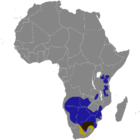
|
Size range: 170 cm (67 in) long, plus 60 cm (24 in) tail (blue wildebeast) to 242 cm (95 in) long, plus 45 cm (18 in) tail (black wildebeast) Habitats: Savanna, shrubland, and grassland Diets: Grass |
| Damaliscus (tsessebe) |
P. L. Sclater, Thomas, 1894
Two species |
Southern Africa
|
Size range: 140 cm (55 in) long, plus 30 cm (12 in) tail (bontebok) to 230 cm (91 in) long, plus 42 cm (17 in) tail (common tsessebe) Habitats: Savanna, shrubland, and grassland Diets: Grass and burnt veldt shrubs |
| Name | Authority and species | Range | Size and ecology |
|---|---|---|---|
| Ammodorcas | Thomas, 1891
One species
|
Horn of Africa
|
Size: 152–168 cm (60–66 in) long, plus 25–35 cm (10–14 in) tail Habitats: Shrubland and grassland Diet: Leaves and shoots |
| Antidorcas | Sundevall, 1847
One species
|
Southwestern Africa | Size: 120–150 cm (47–59 in) long, plus 14–28 cm (6–11 in) tail Habitats: Savanna, shrubland, grassland, and desert Diet: Shrubs and grass |
| Antilope | Pallas, 1766
One species
|
India (former range in light green)
|
Size: Up to 120 cm (47 in) long Habitats: Forest, grassland, and desert Diet: Grass, as well as leaf litter, flowers, and fruit |
| Dorcatragus | Noack, 1894
One species
|
Horn of Africa
|
Size: 76–87 cm (30–34 in) long, plus 5–8 cm (2–3 in) tail Habitats: Shrubland, and rocky areas Diet: Shrubs |
| Eudorcas | Fitzinger, 1869
Five species
|
Sub-Saharan Africa | Size range: 55 cm (22 in) long, plus 15 cm (6 in) tail (Heuglin's gazelle) to 120 cm (47 in) long, plus 27 cm (11 in) tail (Mongalla gazelle, Red-fronted gazelle, Thomson's gazelle) Habitats: Forest, savanna, shrubland, and grassland Diets: Grass and shrubs, as well as forbs and fruit |
| Gazella (gazelle) |
Blainville, 1816
Ten species
|
North Africa, Arabian Peninsula, Asia | Size range: 90 cm (35 in) long, plus 15 cm (6 in) tail (Dorcas gazelle) to 125 cm (49 in) long, plus 20 cm (8 in) tail (Erlanger's gazelle) Habitats: Forest, shrubland, grassland, rocky areas, desert, and coastal marine Diets: Grass, forbs, leaves, crops, fruit, and low plants |
| Litocranius | Kohl, 1886
One species
|
Horn of Africa
|
Size: 140–160 cm (55–63 in) long, plus 2–4 cm (1–2 in) tail Habitats: Savanna and shrubland Diet: Shrubs |
| Madoqua (dik-dik) |
(Ogilby, 1837)
Four species
|
Eastern and southwestern Africa | Size range: 45 cm (18 in) long, plus 3 cm (1 in) tail (silver dik-dik) to 67 cm (26 in) long, plus 6 cm (2 in) tail (Kirk's dik-dik, Salt's dik-dik) Habitats: Forest and shrubland Diets: Shrubs, leaves, and grass, as well as flowers, herbs, and sedges |
| Nanger | Lataste, 1885
Three species
|
Eastern Africa and scattered Saharan Desert | Size range: 125 cm (49 in) long, plus 18 cm (7 in) tail (Soemmerring's gazelle) to 168 cm (66 in) long (Dama gazelle) Habitats: Savanna, shrubland, grassland, and desert Diets: Leaves, grass, stems, shrubs, and herbs |
| Neotragus | H. Smith, 1827
One species
|
Sub-Saharan Africa | Size: 38 cm (15 in) long, plus 5 cm (2 in) tail Habitats: Forest and shrubland Diet: Leaves and shoots, as well as fruit and fungi |
| Oreotragus | A. Smith, 1834
One species
|
Southern and Eastern Africa
|
Size: 75–115 cm (30–45 in) long Habitats: Savanna, shrubland, rocky areas, and desert Diet: Shrubs |
| Ourebia | Laurillard, 1842
One species
|
Sub-Saharan Africa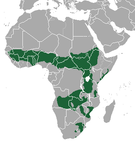
|
Size: 92–110 cm (36–43 in) long Habitats: Savanna and grassland Diet: Grass and shrubs |
| Procapra | Hodgson, 1846
Three species
|
Central Asia | Size range: 91 cm (36 in) long, plus 8 cm (3 in) tail (goa) to 130 cm (51 in) long (Mongolian gazelle) Habitats: Grassland, inland wetlands, and desert Diets: Grass, onions, forbs, legumes, sedges, and shrubs |
| Raphicerus | H. Smith, 1827
Three species
|
Southern Africa | Size range: 65 cm (26 in) long, plus 4 cm (2 in) tail (Sharpe's grysbok) to 95 cm (37 in) long, plus 6 cm (2 in) tail (steenbok) Habitats: Savanna, shrubland, and grassland Diets: Shrubs, grass, geophytes, berries, flowers, and fruit |
| Saiga | J. E. Gray, 1843
One species
|
Central Asia (historical range in white)
|
Size: 108–146 cm (43–57 in) long, plus 6–13 cm (2–5 in) tail Habitats: Grassland and desert Diet: Grass |
| Name | Authority and species | Range | Size and ecology |
|---|---|---|---|
| Bison (bison) |
H. Smith, 1827
Two species
|
Scattered North America and Europe | Size range: 210–380 cm (83–150 in) long, plus 43–90 cm (17–35 in) tail (American bison) Habitats: Forest, savanna, shrubland, grassland, inland wetlands, and desert Diets: Grass, leaves, sedges, herbs, and roots, as well as trees, shrubs, and sagebrush |
| Bos | Linnaeus, 1758
Ten species
|
Central, southern, and southeastern Asia, plus worldwide distribution of cattle | Size range: 145 cm (57 in) long, plus 60 cm (24 in) tail (yak), to 385 cm (152 in) long, plus 60 cm (24 in) tail (wild yak) Habitats: Forest, savanna, grassland, shrubland, rocky areas, and desert Diets: Grass, sedges, shrubs, forbs, herbs, and bamboo, as well as leaves, fruit, flowers, lichen, moss, bark, and young branches of shrubs and trees |
| Boselaphus | Blainville, 1816
One species
|
Indian subcontinent
|
Size: 180–200 cm (71–79 in) long Habitats: Forest, shrubland, and grassland Diet: Grass and shrubs |
| Bubalus | H. Smith, 1827
Five species
|
Scattered southeast Asia, as well as scattered Asia, Egypt, and South America | Size range: 122 cm (48 in) long (mountain anoa) to 300 cm (118 in) long, plus 100 cm (39 in) tail (water buffalo, wild water buffalo) Habitats: Forest, shrubland, savanna, grassland, and inland wetlands Diets: Grass, shrubs, sedges, and young bamboo shoots, as well as herbs, fruit, and leaves |
| Pseudoryx | Dung, Giao, Chinh, Tuoc, Arctander, MacKinnon, 1993
One species
|
Annamite Range of Vietnam and Laos
|
Size: 143–150 cm (56–59 in) long, plus up to 25 cm (10 in) tail Habitats: Forest Diet: Leaves as well as shrubs |
| Syncerus | Hodgson, 1847
One species
|
Sub-Saharan Africa
|
Size: 240–340 cm (94–134 in) long, plus 75–110 cm (30–43 in) tail Habitats: Forest, savanna, shrubland, grassland, and inland wetlands Diet: Grass |
| Taurotragus (eland) |
Wagner, 1855
Two species
|
Sub-Saharan Africa | Size range: 200 cm (79 in) long, plus 50 cm (20 in) tail (common eland), to 345 cm (136 in) long, plus 70 cm (28 in) tail (giant eland) Habitats: Forest, savanna, shrubland, and grassland Diets: Leaves, shrubs, shoots, herbs, and fruit, as well as grass |
| Tetracerus | Leach, 1825
One species
|
Indian subcontinent
|
Size: 80–110 cm (31–43 in) long, plus 10–15 cm (4–6 in) tail Habitats: Forest and shrubland Diet: Grass and shrubs |
| Tragelaphus | (Blainville, 1816)
Seven species
|
Sub-Saharan Africa | Size range: 105 cm (41 in) long, plus 19 cm (7 in) tail (harnessed bushbuck) to 260 cm (102 in) long (mountain nyala) Habitats: Forest, savanna, shrubland, grassland, desert, and inland wetlands Diets: Grass, sedges, herbs, leaves, fruit, and shrubs |
| Name | Authority and species | Range | Size and ecology |
|---|---|---|---|
| Ammotragus | (Blyth, 1840)
One species
|
Northern Africa | Size: 130–165 cm (51–65 in) long, plus 12–25 cm (5–10 in) tail Habitats: Savanna, shrubland, grassland, rocky areas, and desert Diet: Grass, shrubs, and forbs |
| Arabitragus | Ropiquet, Hassanin, 2005
One species
|
Eastern Arabia
|
Size: 93–95 cm (37–37 in) long, plus up to 8–10 cm (3–4 in) tail Habitats: Shrubland, rocky areas, and desert Diet: Grass, forbs, shrubs, and trees |
| Budorcas | Hodgson, 1850
One species
|
Eastern Himalayas
|
Size: 170–220 cm (67–87 in) long, plus 15 cm (6 in) tail Habitats: Forest, shrubland, and grassland Diet: Grass, bamboo shoots, forbs, and leaves |
| Capra (goat) |
Linnaeus, 1758
Nine species
|
Scattered Europe, Northeast Africa, and western and central Asia
|
Size range: 100 cm (39 in) long, plus 10 cm (4 in) tail (Iberian ibex) to 185 cm (73 in) long, plus 14 cm (6 in) tail (markhor) Habitats: Forest, shrubland, grassland, desert, and rocky areas Diets: Grass, shrubs, trees, herbs, lichens, and a variety of other plants |
| Capricornis (serow) |
Ogilby, 1836
Four species
|
Eastern Asia | Size range: 80 cm (31 in) long, plus 7 cm (3 in) tail (Taiwan serow) to 155 cm (61 in) long, plus 16 cm (6 in) tail (mainland serow) Habitats: Forest, shrubland, grassland, and rocky areas Diets: Grass, shoots, leaves, shrubs, acorns, and twigs |
| Hemitragus | (Hodgson, 1841)
One species
|
Himalayas
|
Size: 90–140 cm (35–55 in) long Habitats: Forest, shrubland, grassland, and rocky areas Diet: Herbaceous plants and shrubs, grass, and sedges |
| Naemorhedus (goral) |
H. Smith, 1827
Four species
|
Himalayas and Eastern Asia | Size range: 81 cm (32 in) long (long-tailed goral) to 130 cm (51 in) long (Himalayan goral) Habitats: Forest, shrubland, grassland, and rocky areas Diets: Grass, herbs, shoots, leaves, nuts, fruit, and lichen |
| Nilgiritragus | Ropiquet, Hassanin, 2005
One species
|
Southern India
|
Size: 90–140 cm (35–55 in) long, plus 9–12 cm (4–5 in) tail Habitats: Shrubland, grassland, and rocky areas Diet: Grass and forbs |
| Oreamnos | Rafinesque, 1817
One species
|
Western North America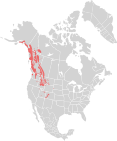
|
Size: 120–160 cm (47–63 in) long, plus 8–20 cm (3–8 in) tail Habitats: Forest, shrubland, grassland, and rocky areas Diet: Grass, forbs, sedges, ferns, moss, lichen, twigs, and leaves |
| Ovibos | Blainville, 1816
One species
|
The Arctic (reintroduced in blue)
|
Size: 190–270 cm (75–106 in) long, plus 7–12 cm (3–5 in) tail Habitats: Grassland Diet: Sedges and grass, as well as shrubs and some forbs |
| Ovis (sheep) |
Linnaeus, 1758
Seven species
|
Asia and western North America, plus worldwide domesticated sheep | Size range: 105 cm (41 in) long, plus 12 cm (5 in) tail (mouflon) to 190 cm (75 in) long (argali) Habitats: Forest, shrubland, grassland, rocky areas, savanna, and desert Diets: Grass and shrubs, as well as a wide variety of vegetation |
| Pantholops | Hodgson, 1834
One species
|
Tibetan Plateau
|
Size: 120–130 cm (47–51 in) long Habitats: Grassland Diet: Grass and herbs |
| Pseudois | Hodgson, 1846
One species
|
Himalayas
|
Size: 120–140 cm (47–55 in) long Habitats: Forest, shrubland, grassland, rocky areas, and desert Diet: Grass, alpine herbs, and lichens |
| Rupicapra | Blainville, 1816
Two species
|
Europe and western Asia
|
Size range: 90 cm (35 in) long, plus 3 cm (1 in) tail (Pyrenean chamois) to 135 cm (53 in) long (chamois) Habitats: Forest, shrubland, grassland, and rocky areas Diets: Grass, herbs, tree leaves, flowers, buds, shoots, and fungi, as well as lichen, moss, and young pine shoots |
| Name | Authority and species | Range | Size and ecology |
|---|---|---|---|
| Cephalophus | H. Smith, 1827
Sixteen species
|
Sub-Saharan Africa | Size range: 60 cm (24 in) long (red-flanked duiker) to 150 cm (59 in) long, plus 16 cm (6 in) tail (Jentink's duiker) Habitats: Forest, savanna, and shrubland Diets: Leaves, fruit, flowers, twigs, nuts, and tree stems, as well as shrubs, grass, insects, and eggs |
| Philantomba | Blyth, 1840
Three species
|
Sub-Saharan Africa | Size range: 36 cm (14 in) long, plus 14 cm (6 in) tail (Maxwell's duiker) to 72 cm (28 in) long, plus 13 cm (5 in) tail (blue duiker) Habitats: Forest and shrubland Diets: Leaves, fruit, seeds, flowers, and fungi |
| Sylvicapra | Ogilby, 1837
One species
|
Sub-Saharan Africa | Size: 70–105 cm (28–41 in) long, plus 10–20 cm (4–8 in) tail Habitats: Forest, savanna, shrubland, grassland, and desert Diet: Variety of foliage, herbs, fruit, seeds, and cultivated crops |
| Name | Authority and species | Range | Size and ecology |
|---|---|---|---|
| Addax | Laurillard, 1841
One species
|
Scattered western Africa
|
Size: 150–170 cm (59–67 in) long, plus 25–35 cm (10–14 in) tail Habitats: Savanna, grassland, and desert Diet: Grass and shrubs |
| Hippotragus | Sundevall, 1846
Three species
|
Sub-Saharan Africa | Size range: 190 cm (75 in) long, plus 37 cm (15 in) tail (roan antelope) to 300 cm (118 in) long (bluebuck) Habitats: Forest, savanna, shrubland, and grassland Diets: Grass, as well as forbs and leaves |
| Oryx (oryx) |
Blainville, 1816
Four species
|
Eastern and southern Africa and Arabian Peninsula | Size range: 153 cm (60 in) long, plus 45 cm (18 in) tail (East African oryx) to 235 cm (93 in) long, plus 90 cm (35 in) tail (Arabian oryx) Habitats: Savanna, shrubland, grassland, and desert Diets: Grass, shrubs, herbs, roots, and buds, as well as fruit and vegetables |
| Name | Authority and species | Range | Size and ecology |
|---|---|---|---|
| Nesotragus | von Düben (de), 1846
Two species
|
Sub-Saharan Africa | Size range: 50 cm (20 in) long, plus 5 cm (2 in) tail (Bates's pygmy antelope) to 62 cm (24 in) long (suni) Habitats: Forest, brush and riparian reed scrub Diets: Leaves and shoots, as well as fruit and fungi |
| Name | Authority and species | Range | Size and ecology |
|---|---|---|---|
| Kobus | Smith, 1840
Five species
|
Sub-Saharan Africa | Size range: 126 cm (50 in) long (puku) to 235 cm (93 in) long (waterbuck) Habitats: Savanna, shrubland, grassland, forest, and inland wetlands Diets: Grass, shrubs, and water plants |
| Pelea | Gray, 1851
One species
|
Southern Africa | Size: 115–125 cm (45–49 in) long Habitats: Savanna and grassland Diet: Shrubs and forbs |
| Redunca (reedbuck) |
H. Smith, 1827
Three species
|
Sub-Saharan Africa | Size range: 100 cm (39 in) long, plus 13 cm (5 in) tail (mountain reedbuck) to 167 cm (66 in) long (southern reedbuck) Habitats: Savanna, shrubland, grassland, rocky areas, and inland wetlands Diets: Grass, as well as herbs and shrubs |
Family Cervidae
Main article: List of cervidsMembers of the Cervidae family are cervids, or colloquially deer. Cervidae comprises 53 extant species, divided into 19 genera. These genera are grouped into two subfamilies: Capreolinae, or New World deer, and Cervinae, or Old World deer.
| Name | Authority and species | Range | Size and ecology |
|---|---|---|---|
| Alces | J. E. Gray, 1821
One species
|
North America, Europe, and Asia
|
Size: 230–340 cm (91–134 in) long, plus 8–12 cm (3–5 in) tail Habitats: Forest and inland wetlands Diet: Vegetative parts of trees, as well as shrubs, herbs, and aquatic plants |
| Blastocerus | Wagner, 1844
One species
|
Scattered parts of central South America (former range in red)
|
Size: 153–191 cm (60–75 in) long, plus 12–16 cm (5–6 in) tail Habitats: Savanna, shrubland, and inland wetlands Diet: Grasses, reeds and aquatic plants, as well as shrubs and vines |
| Capreolus (roe deer) |
J. E. Gray, 1821
Two species
|
Europe and Asia
|
Size range: 95 cm (37 in) long, plus 20 cm (8 in) tail (Siberian roe deer) to 124 cm (49 in) long, plus 3 cm (1 in) tail (roe deer) Habitats: Forest, shrubland, grassland, and inland wetlands Diets: Wide variety of plants |
| Hippocamelus | Leuckart, 1816
Two species
|
Western South America | Size range: 69–77 cm (27–30 in) tall at shoulder (taruca) to 156 cm (61 in) long, plus 13 cm (5 in) tail; 80–90 cm (31–35 in) tall at shoulder (South Andean deer) Habitats: Forest, shrubland, grassland, inland wetlands, rocky areas, and desert Diets: Sedges, grass, and other plants |
| Hydropotes | H. Milne-Edwards, 1872
One species
|
East China and Korean peninsula | Size: 89–103 cm (35–41 in) long, plus 6–7 cm (2–3 in) tail; 45–57 cm (18–22 in) tall at shoulder Habitats: Forest, shrubland, grassland, inland wetlands, and intertidal marine Diet: Reeds, coarse grasses, vegetables, and beets |
| Mazama (brocket deer) |
Rafinesque, 1817
Nine species
|
South America and Central America | Size range: 70 cm (28 in) long (dwarf brocket) to 146 cm (57 in) long, plus 15 cm (6 in) tail (red brocket) Habitats: Forest, shrubland, grassland, inland wetlands, and rocky areas Diets: Wide variety of plants and fruit |
| Odocoileus | Rafinesque, 1832
Three species
|
North America and northern South America | Size range: 105 cm (41 in) long, plus 8 cm (3 in) tail (Yucatan brown brocket) to 203 cm (80 in) long (mule deer) Habitats: Forest, savanna, shrubland, grassland, inland wetlands, desert, neritic marine, intertidal marine, and coastal marine Diets: Wide variety of vegetation and grasses |
| Ozotoceros | Ameghino, 1891
One species
|
Scattered central South America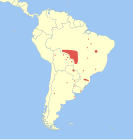
|
Size: 110–140 cm (43–55 in) long; 70–75 cm (28–30 in) tall at shoulder Habitats: Savanna, grassland, and inland wetlands Diet: Grasses and shrubs |
| Pudu (pudú) |
J. E. Gray, 1852
Two species
|
Western South America | Size range: 60–85 cm (24–33 in) long, plus 3–5 cm (1–2 in) tail Habitats: Forest, shrubland, and grassland Diets: Leaves of ferns, trees, vines, herbs and shrubs |
| Rangifer | H. Smith, 1827
One species
|
Arctic North America, Europe, and Asia
|
Size: 150–230 cm (59–91 in) long; up to 120 cm (47 in) tall at shoulder Habitats: Forest and grassland Diet: Lichen, forbs, sedges, grasses, and shrubs |
| Name | Authority and species | Range | Size and ecology |
|---|---|---|---|
| Axis | H. Smith, 1827
Four species
|
Southern and southeast Asia | Size range: 70 cm (28 in) long, plus 20 cm (8 in) tail (chital) to 175 cm (69 in) long, plus 38 cm (15 in) tail (Calamian deer) Habitats: Forest, savanna, shrubland, grassland, and inland wetlands Diets: Wide variety of grasses as well as fallen leaves, flowers, and fruit |
| Cervus | Linnaeus, 1758
Five species
|
Southern and southeast Asia | Size range: 95 cm (37 in) long, plus 7 cm (3 in) tail (sika deer) to 280 cm (110 in) long, plus 22 cm (9 in) tail (elk) Habitats: Forest, shrubland, grassland, rocky areas, and inland wetlands Diets: Shrub and tree shoots and branches, as well as grass, sedges, shrubs, fruit, and seeds |
| Dama | Frisch, 1775
Two species
|
Europe and west Asia; introduced scattered areas worldwide | Size range: 130–175 cm (51–69 in) long, plus 15–23 cm (6–9 in) tail Habitats: Forest, shrubland, and grassland Diets: Grasses, mast, and shrubs, as well as leaves, buds, shoots, and bark |
| Elaphodus | H. Milne-Edwards, 1872
One species
|
Central China and northeastern Myanmar | Size: 110–160 cm (43–63 in) long, plus 7–16 cm (3–6 in) tail Habitats: Forest and shrubland Diet: Grass, as well as shrubs, fruits, bamboo, and herbs |
| Elaphurus | Milne-Edwards, 1866
One species
|
China | Size: 183–216 cm (72–85 in) long, plus 22–36 cm (9–14 in) tail Habitats: Grassland, inland wetlands, and intertidal marine Diet: Grass, reeds, and bush leaves |
| Muntiacus (muntjac) |
Rafinesque, 1815
Twelve species
|
South and southeast Asia; introduced to Britain
|
Size range: 70 cm (28 in) long, plus 10 cm (4 in) tail (Reeves's muntjac) to 135 cm (53 in) long, plus 23 cm (9 in) tail (Northern red muntjac) Habitats: Forest, shrubland, and grassland Diets: Fruit and a range of plant materials |
| Panolia | McClelland, 1842
One species
|
Scattered parts of south and southeast Asia | Size range: 140–170 cm (55–67 in) long, plus 22–25 cm (9–10 in) tail Habitats: Forest, savanna, shrubland, grassland, and inland wetlands Diets: A variety of grass, fruit, and herbaceous and wetland plants |
| Rucervus | Hodgson, 1838
Two species
|
Scattered parts of south and southeast Asia | Size range: 140 cm (55 in) long, plus 22 cm (9 in) tail (Eld's deer) to 180 cm (71 in) long (barasingha) Habitats: Forest, savanna, shrubland, grassland, and inland wetlands Diets: A variety of grass, fruit, and herbaceous and wetland plants |
| Rusa | H. Smith, 1827
Four species
|
South and Southeast Asia | Size range: 100 cm (39 in) long (Philippine deer) to 270 cm (106 in) long, plus 30 cm (12 in) tail (sambar deer) Habitats: Forest, savanna, shrubland, grassland, and inland wetlands Diets: Wide variety of plants |
Family Giraffidae
Main article: GiraffidaeMembers of the Giraffidae family are giraffids, and are the giraffes and the okapi. Giraffidae comprises five extant species in two genera.
| Name | Authority and species | Range | Size and ecology |
|---|---|---|---|
| Giraffa (giraffe) |
Brisson, 1762
Four species
|
Scattered Sub-Saharan Africa (species shown as subspecies)
|
Size range: 380–470 cm (150–185 in) long, plus 78–100 cm (31–39 in) tail; 600–1,800 kg (1,323–3,968 lb) Habitats: Forest, savanna, shrubland Diets: Leaves, stems, flowers, and fruit |
| Okapia | Lankester, 1901
One species
|
Democratic Republic of the Congo in Central Africa
|
Size: 200–220 cm (79–87 in) long, plus 30–42 cm (12–17 in) tail; 200–350 kg (441–772 lb) Habitats: Forest Diet: Leaves |
Family Moschidae
Main article: MoschidaeMembers of the Moschidae family are moschids, or colloquially musk deer. Moschidae contains seven extant species in a single genus.
| Name | Authority and species | Range | Size and ecology |
|---|---|---|---|
| Moschus (musk deer) |
Linnaeus, 1758
Seven species
|
Southern Asia | Size range: 80–100 cm (31–39 in) long, plus 4–6 cm (2–2 in) tail Habitats: Forest, shrubland, grassland, and rocky areas Diets: Leaves, flowers, shoots, and grass, as well as twigs, moss, and lichen |
Family Tragulidae
Main article: TragulidaeMembers of the Tragulidae family are tragulids, or colloquially chevrotains or mouse-deer. Tragulidae contains 10 extant species in 3 genera.
| Name | Authority and species | Range | Size and ecology |
|---|---|---|---|
| Hyemoschus | Brisson, 1762
One species
|
Central and western Africa
|
Size: 45–85 cm (18–33 in) long, plus 7–17 cm (3–7 in) tail Habitats: Forest Diet: Tree and shrub leaves, fruit, and buds |
| Moschiola (spotted chevrotain) |
J. E. Gray, 1845
Three species
|
Southern Asia | Size range: 50–56 cm (20–22 in) long, plus 2–3 cm (1–1 in) tail Habitats: Forest, savanna, shrubland, grassland, inland wetlands, and marine Diets: Herbs, shrubs, and fruit |
| Tragulus (mouse-deer) |
J. E. Gray, 1845
Six species
|
Southeast Asia | Size range: 40–58 cm (16–23 in) long, plus 6–10 cm (2–4 in) tail Habitats: Forest, savanna, shrubland, grassland, and inland wetlands Diets: Fruit, as well as shoots and young leaves |
Suborder Suina
Main article: List of suinesFamily Suidae
Members of the Suidae family are suids, or colloquially pigs, hogs, or boars. Suidae comprises 17 extant species, divided into 6 genera, and is not split into subfamilies.
| Name | Authority and species | Range | Size and ecology |
|---|---|---|---|
| Babyrousa (deer-pig) |
Perry, 1811
Three species
|
Indonesia | Size range: 85–110 cm (33–43 in) long, plus 20–32 cm (8–13 in) tail (Buru babirusa and North Sulawesi babirusa) Habitats: Forest, inland wetlands, and intertidal marine Diets: Fruit and browse, as well as rhizomes, tamarinds, cacao, herbs, and vegetables |
| Hylochoerus | Thomas, 1904
One species
|
Scattered central Africa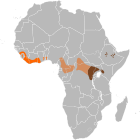
|
Size: 130–210 cm (51–83 in) long, plus 25–45 cm (10–18 in) tail Habitats: Forest Diet: Large variety of plants, particularly herbaceous plants |
| Phacochoerus (warthog) |
F. Cuvier, 1826
Two species
|
Sub-saharan Africa | Size range: 90–150 cm (35–59 in) long (common warthog) Habitats: Forest, savanna, shrubland, and grassland Diets: Grass, shrubs, and tubers, as well as fruit, insects, roots, berries, bark, and carrion |
| Porcula | Hodgson, 1847
One species
|
Southern Bhutan and northwest India | Size: 55–71 cm (22–28 in) long, plus tail Habitats: Grassland Diet: Roots, grass, tubers, and invertebrates |
| Potamochoerus (bushpig) |
J. E. Gray, 1854
Two species
|
Sub-Saharan Africa | Size range: 100–150 cm (39–59 in) long, plus 30–40 cm (12–16 in) tail (red river hog) Habitats: Forest and shrubland Diets: Roots, tubers, fruit, seeds, invertebrates, small vertebrates, and carrion |
| Sus (pig) |
Linnaeus, 1758
Eight species
|
Southeast Asia, with wild boar in Eurasia and North Africa and introduced to parts of United States, South America, and Oceania | Size range: 80 cm (31 in) long (Celebes warty pig) to 200 cm (79 in) long, plus 40 cm (16 in) tail (wild boar) Habitats: Forest, savanna, shrubland, grassland, inland wetlands, neritic marine, intertidal marine, and desert Diets: Omnivorous; wide variety of plants and small vertebrates |
Family Tayassuidae
Members of the Tayassuidae family are tayassuids, or colloquially peccaries. Tayassuidae comprises 3 extant species in 3 genera, and is not split into subfamilies.
| Name | Authority and species | Range | Size and ecology |
|---|---|---|---|
| Catagonus | Ameghino, 1904
One species
|
Gran Chaco region of central South America
|
Size: 96–118 cm (38–46 in) long Habitats: Savanna and shrubland Diet: Cacti, as well as roots, fruit, and forbs |
| Dicotyles | Linnaeus, 1758
One species
|
South America, Central America, Trinidad in the Caribbean, and southern North America
|
Size: 80–100 cm (31–39 in) long Habitats: Forest, savanna, shrubland, grassland, and desert Diet: Roots, tubers, fruits, seeds, as well as green plants, insects, and small animals |
| Tayassu | Fischer von Waldheim, 1814
One species
|
South America and Central America
|
Size: 75–100 cm (30–39 in) long, plus 1–6 cm (0–2 in) tail Habitats: Forest, savanna, shrubland, and grassland Diet: Fruit, as well as a variety of plants, invertebrates, fungi and fish |
Suborder Tylopoda
Family Camelidae
Main article: CamelidaeMembers of the Camelidae family are camelids, and include camels, llamas, and alpacas. Camelidae contains 7 extant species in 2 genera.
| Name | Authority and species | Range | Size and ecology |
|---|---|---|---|
| Camelus (camel) |
Linnaeus, 1758
Three species
|
Northern Africa, Middle East, central Asia, central Australia | Size range: 220 cm (87 in) long, plus 20 cm (8 in) tail (dromedary) to 320 cm (126 in) long, plus 25 cm (10 in) tail (wild Bactrian camel) Habitats: Desert Diets: Wide variety of plants, as well as carrion |
| Lama | Cuvier, 1800
Four species |
Western and southern South America | Size range: 90 cm (35 in) long, plus 24 cm (9 in) tail (guanaco) to 225 cm (89 in) long, plus 25 cm (10 in) tail (alpaca) Habitats: Shrubland, grassland, inland wetlands, desert Diets: Grass, forbs, shrubs, and lichen |
Suborder Whippomorpha
Infraorder Cetacea
Main article: List of cetaceansParvorder Mysticeti
Family Balaenidae
Main article: BalaenidaeMembers of the Balaenidae family are balaenids, or colloquially right whales. Balaenidae contains four species in two genera.
| Name | Authority and species | Range | Size and ecology |
|---|---|---|---|
| Balaena | Linnaeus, 1758
One species
|
Arctic and subarctic ocean
|
Size: 18–20 m (59–66 ft) long; 98 tons Habitats: Neritic marine and oceanic marine Diet: Small crustaceans and other zooplankton |
| Eubalaena (right whale) |
J. E. Gray, 1864
Three species
|
Subarctic and Antarctic ocean (southern right whale in yellow, North Atlantic right whale in green, North Pacific right whale in blue)
|
Size range: 11–18 m (36–59 ft) long; 54–73 tons Habitats: Neritic marine and oceanic marine Diets: Copepods and krill, as well as other zooplankton |
Family Balaenopteridae
Main article: RorqualMembers of the Balaenopteridae family are balaenopterids, or colloquially rorquals. Balaenopteridae contains eleven species in three genera.
| Name | Authority and species | Range | Size and ecology |
|---|---|---|---|
| Balaenoptera | Linnaeus, 1758
Nine species
|
Worldwide oceans | Size range: 7 m (23 ft) long and 5 tons (common minke whale) to 27 m (89 ft) long and 120 tons (blue whale) Habitats: Neritic marine and oceanic marine Diets: Fish, crustaceans, and cephalopods |
| Eschrichtius | J. E. Gray, 1846
One species
|
Northern Pacific oceans
|
Size: 12–14 m (39–46 ft) long; 15–35 tons Habitats: Neritic marine and oceanic marine Diet: Mysids, tube-dwelling amphipods, and Polychaete tube worms, as well as other crustaceans and zooplankton |
| Megaptera | J. E. Gray, 1864
One species
|
Worldwide oceans
|
Size: 11.5–15 m (38–49 ft) long; 25–30 tons Habitats: Neritic marine and oceanic marine Diet: Krill and crustaceans, as well as fish |
Family Cetotheriidae
Main article: CetotheriidaeMembers of the Cetotheriidae family are cetotheriids; the only extant species is the pygmy right whale.
| Name | Authority and species | Range | Size and ecology |
|---|---|---|---|
| Caperea | J. E. Gray, 1864
One species
|
Sub-Antarctic oceans
|
Size: 5.5–6.5 m (18–21 ft) long; 3–3.5 tons Habitats: Neritic marine and oceanic marine Diet: Copepods as well as other zooplankton |
Parvorder Odontoceti
Family Delphinidae
Main article: Oceanic dolphinMembers of the Delphinidae family are delphinids, or colloquially oceanic dolphins. Delphinidae contains 37 species in 19 genera, which are grouped into four named subfamilies: Delphininae, Lissodelphininae, Globicephalinae, and Orcininae, as well as one unnamed group.
| Name | Authority and species | Range | Size and ecology |
|---|---|---|---|
| Delphinus | Linnaeus, 1758
One species
|
Tropical and temperate Pacific, Atlantic and Indian Oceans
|
Size: 170–240 cm (67–94 in) long; 70–110 kg (154–243 lb) Habitats: Neritic marine and oceanic marine Diet: Epipelagic and mesopelagic fish as well as squid |
| Lagenodelphis | Fraser, 1956
One species
|
Tropical and temperate Pacific, Atlantic and Indian Oceans
|
Size: 200–260 cm (79–102 in) long; 160–210 kg (353–463 lb) Habitats: Neritic marine and oceanic marine Diet: Mesopelagic fish, cephalopods, and crustaceans |
| Sotalia | J. E. Gray, 1866
Two species
|
Northern and eastern South American coast and Amazon basin rivers
|
Size range: 130–180 cm (51–71 in) long; 35–45 kg (77–99 lb) Habitats: Neritic marine, coastal marine, and inland wetlands Diets: Fish, cephalopods, and shrimp |
| Sousa (humpback dolphin) |
J. E. Gray, 1866
Four species
|
Western African coast; Indian Ocean coasts; western Pacific Ocean | Size range: 200 cm (79 in) long and 100 kg (220 lb) (Indo-Pacific humpback dolphin) to 280 cm (110 in) long and 200 kg (441 lb) (Atlantic humpback dolphin) Habitats: Neritic marine, coastal marine, intertidal marine, oceanic marine, and inland wetlands Diets: Wide variety of coastal fish, as well as cephalopods |
| Stenella (spotted dolphin) |
J. E. Gray, 1866
Five species
|
Worldwide tropical and temperate oceans | Size range: 130 cm (51 in) long and 45 kg (99 lb) (spinner dolphin) to 250 cm (98 in) long and 150 kg (331 lb) (striped dolphin) Habitats: Neritic marine and oceanic marine Diets: Small fish, squid, and shrimp |
| Tursiops (bottlenose dolphin) |
Gervais, 1855
Two species
|
Worldwide tropical and temperate oceans
|
Size range: 190–390 cm (75–154 in) long; 150–650 kg (331–1,433 lb) Habitats: Neritic marine, coastal marine, oceanic marine, and inland wetlands Diets: Wide variety of fish and cephalopods, as well as shrimp and crustaceans |
| Name | Authority and species | Range | Size and ecology |
|---|---|---|---|
| Cephalorhynchus | J. E. Gray, 1846
Four species
|
Southern South American coast, southwestern African coast, New Zealand coast, and Kerguelen Islands in Indian Ocean | Size range: 120 cm (47 in) long and 30 kg (66 lb) (Chilean dolphin) to 170 cm (67 in) long and 75 kg (165 lb) (Heaviside's dolphin) Habitats: Neritic marine and oceanic marine Diets: Small fish, cephalopods, crustaceans, and benthic invertebrates |
| Lissodelphis (right whale dolphin) |
Gloger, 1841
Two species
|
Temperate north Pacific Ocean and temperate to sub-Antarctic Pacific and Atlantic Oceans
|
Size range: 180 cm (71 in) long and 60 kg (132 lb) (southern right whale dolphin) to 300 cm (118 in) long and 100 kg (220 lb) (Northern right whale dolphin) Habitats: Neritic marine and oceanic marine Diets: Squid and fish |
| Name | Authority and species | Range | Size and ecology |
|---|---|---|---|
| Feresa | J. E. Gray, 1870
One species
|
Worldwide tropical and subtropical oceans
|
Size: 210–260 cm (83–102 in) long; 110–170 kg (243–375 lb) Habitats: Oceanic marine Diet: Fish and cephalopods |
| Globicephala (pilot whale) |
Lesson, 1828
Two species
|
Worldwide oceans (short-finned in blue, long-finned in green)
|
Size range: 360–650 cm (142–256 in) long; 1–4 tons Habitats: Oceanic marine Diets: Squid, as well as small and medium fish and shrimp |
| Grampus | J. E. Gray, 1828
One species
|
Worldwide tropical and temperate ocean continental shelves
|
Size: 260–380 cm (102–150 in) long; 300–500 kg (661–1,102 lb) Habitats: Oceanic marine Diet: Cephalopods |
| Orcaella (snubfin dolphin) |
Lesson, 1866
Two species
|
Southeast Asian and northern Australian coasts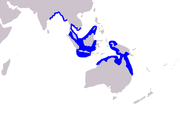
|
Size range: 210–260 cm (83–102 in) long; 90–150 kg (198–331 lb) Habitats: Neretic marine, coastal marine, and inland wetlands Diets: Fish, as well as squid and shrimp |
| Peponocephala | Nishiwaki, Norris, 1966
One species
|
Worldwide tropical and subtropical oceans
|
Size: 210–270 cm (83–106 in) long; about 160 kg (353 lb) Habitats: Oceanic marine Diet: Mesopelagic fish, squid, and shrimp |
| Pseudorca | Reinhardt, 1862
One species
|
Worldwide tropical and temperate oceans
|
Size: 430–600 cm (169–236 in) long; 1.1–2.2 tons Habitats: Neritic marine and oceanic marine Diet: Large fish and cephalopods |
| Steno | J. E. Gray, 1846
One species
|
Worldwide tropical and temperate oceans
|
Size: 210–260 cm (83–102 in) long; 100–150 kg (220–331 lb) Habitats: Neritic marine and oceanic marine Diet: Fish and cephalopods |
| Name | Authority and species | Range | Size and ecology |
|---|---|---|---|
| Orcinus | Fitzinger, 1860
One species
|
Worldwide oceans
|
Size: 550–980 cm (217–386 in) long; 2.6–9 tons Habitats: Neritic marine and oceanic marine Diet: Wide variety of prey, including marine mammals, seabirds, sea turtles, many species of fish, sharks, rays, and cephalopods |
| Name | Authority and species | Range | Size and ecology |
|---|---|---|---|
| Lagenorhynchus | Cope, 1866
Six species
|
Temperate and subarctic northern Atlantic Ocean, Sub-Antarctic Pacific and Atlantic Oceans, temperate north Pacific Ocean, and scattered southern hemisphere coasts | Size range: 150 cm (59 in) long and 50 kg (110 lb) (dusky dolphin) to 270 cm (106 in) long and 275 kg (606 lb) (White-beaked dolphin) Habitats: Neritic marine and oceanic marine Diets: Wide variety of fish and cephalopods |
Family Iniidae
Main article: IniidaeMembers of the Iniidae family are inniids, and are part of a grouping colloqially termed river dolphins along with Lipotidae, Platanistidae and Pontoporiidae. Iniidae contains four species in one genus.
| Name | Authority and species | Range | Size and ecology |
|---|---|---|---|
| Inia | d'Orbigny, 1834
Four species
|
Amazon rivers in South America (Araguaian river dolphin in blue, Amazon and Orinoco river dolphins in green, and Bolivian river dolphin in purple)
|
Size range: 180–250 cm (71–98 in) long; 85–160 kg (187–353 lb) Habitats: Inland wetlands Diets: Fish, as well as shrimp |
Family Kogiidae
Main article: KogiidaeMembers of the Kogiidae family are kogiids, and are part of the sperm whale superfamily Physeteroidea; the family contains two species in one genus.
| Name | Authority and species | Range | Size and ecology |
|---|---|---|---|
| Kogia | G. R. Gray, 1864
Two species
|
Worldwide tropical and temperate oceans | Size range: 210 cm (83 in) long and 135 kg (298 lb) (dwarf sperm whale) to 340 cm (134 in) long and 400 kg (882 lb) (pygmy sperm whale) Habitats: Oceanic marine Diets: Cephalopods, as well as fish, shrimp, and crabs |
Family Lipotidae
Main article: LipotidaeMembers of the Lipotidae family are lipotids and are part of the river dolphin grouping along with Iniidae, Platanistidae and Pontoporiidae; the only extant species is the baiji.
| Name | Authority and species | Range | Size and ecology |
|---|---|---|---|
| Lipotes | Miller, 1918
One species
|
Yangtze river in China
|
Size: 140–250 cm (55–98 in) long; 100–160 kg (220–353 lb) Habitats: Inland wetlands Diet: Fish |
Family Monodontidae
Main article: MonodontidaeMembers of the Monodontidae family are monodontids and comprises two living whale species in two genera, the narwhal and the beluga whale.
| Name | Authority and species | Range | Size and ecology |
|---|---|---|---|
| Delphinapterus | Lacépède, 1804
One species
|
Arctic and subarctic oceans
|
Size: 300–500 cm (118–197 in) long; 0.4–1.5 tons Habitats: Neritic marine and oceanic marine Diet: Fish, as well as mollusks and benthic crustaceans |
| Monodon | Lacépède, 1804
One species
|
Arctic ocean
|
Size: 380–500 cm (150–197 in) long; 0.8–1.6 tons Habitats: Neritic marine and oceanic marine Diet: Fish, squid, and shrimp |
Family Phocoenidae
Main article: PhocoenidaeMembers of the Phocoenidae family are phocoenids, or colloquially porpoises. Phocoenidae contains eight species in three genera.
| Name | Authority and species | Range | Size and ecology |
|---|---|---|---|
| Neophocaena (finless porpoise) |
Palmer, 1899
Three species
|
Asian coasts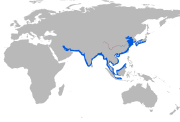
|
Size range: 120–190 cm (47–75 in) long; 30–45 kg (66–99 lb) Habitats: Inland wetlands, neritic marine, oceanic marine, intertidal marine, and coastal marine Diets: Small fish, cephalopods, and crustaceans |
| Phocoena | Cuvier, 1816
Four species
|
North Atlantic, North Pacific, and Antarctic oceans, Black Sea, and South American coast | Size range: 130–220 cm (51–87 in) long; 60–84 kg (132–185 lb) (spectacled porpoise) Habitats: Neritic marine and oceanic marine Diets: Fish, shrimp, squid, and crustaceans |
| Phocoenoides | (Andrews, 1911)
One species
|
North Pacific ocean
|
Size: 170–220 cm (67–87 in) long; 135–220 kg (298–485 lb) (spectacled porpoise) Habitats: Neritic marine and oceanic marine Diet: Wide variety of fish, squid |
Family Physeteridae
Main article: PhyseteridaeMembers of the Physeteridae family are physeterids, and are part of the sperm whale superfamily Physeteroidea; the only extant species is the sperm whale.
| Name | Authority and species | Range | Size and ecology |
|---|---|---|---|
| Physeter | Linnaeus, 1758
One species
|
Worldwide oceans (concentrations in black)
|
Size: 11–18 m (36–59 ft) long; 20–50 tons Habitats: Neritic marine and oceanic marine Diet: Deep-water squid |
Family Platanistidae
Main article: PlatanistidaeMembers of the Platanistidae family are platanistids, and are part of a grouping colloqially termed river dolphins along with Iniidae, Lipotidae, and Pontoporiidae. Platanistidae contains two species in one genus.
| Name | Authority and species | Range | Size and ecology |
|---|---|---|---|
| Platanista (South Asian river dolphin) |
Wagler, 1830
Two species
|
Ganges river (dark blue) and Indus river (light blue)
|
Size range: 150–250 cm (59–98 in) long; 70–90 kg (154–198 lb) Habitats: Neritic marine and inland wetlands Diets: Fish and shrimp |
Family Pontoporiidae
Main article: PontoporiidaeMembers of the Pontoporiidae family are pontoporiids, and are part of a grouping colloqially termed river dolphins along with Iniidae, Lipotidae, and Platanistidae. The only extant species is the La Plata dolphin.
| Name | Authority and species | Range | Size and ecology |
|---|---|---|---|
| Pontoporia | J. E. Gray, 1846
One species
|
Southeastern South American coast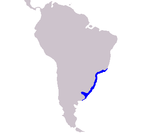
|
Size: 130–170 cm (51–67 in) long; 30–53 kg (66–117 lb) Habitats: Neritic marine and oceanic marine Diet: Fish, cephalopods, and crustaceans |
Family Ziphiidae
Main article: Beaked whaleMembers of the Ziphiidae family are ziphiids, or colloquially beaked whales. Ziphiidae contains 23 species in 6 genera, which are grouped into three named subfamilies: Berardiinae, Hyperoodontinae, and Ziphiinae.
| Name | Authority and species | Range | Size and ecology |
|---|---|---|---|
| Berardius (four-toothed whale) |
Duvernoy, 1851
Three species
|
Antarctic, subantarctic, and north Pacific oceans | Size range: 7.8 m (26 ft) long and 7 tons (Arnoux's beaked whale) to 12.8 m (42 ft) long and 16 tons (Baird's beaked whale) Habitats: Oceanic marine Diets: Deepwater and pelagic fish, cephalopods, and crustaceans |
| Name | Authority and species | Range | Size and ecology |
|---|---|---|---|
| Hyperoodon (bottlenose whale) |
Lacépède, 1804
Two species
|
Antarctic, subantarctic, and north Atlantic oceans | Size range: 6–9 m (20–30 ft) long; 5.8–8 tons Habitats: Oceanic marine Diets: Squid, as well as fish, sea cucumbers, starfish, and prawns |
| Indopacetus | Moore, 1968
One species
|
Small ocean regions near Horn of Africa and Australia
|
Size: 7–7.5 m (23–25 ft) long Habitats: Oceanic marine Diet: Squid |
| Mesoplodon (mesoplodont whale) |
Gervais, 1850
Fifteen species
|
Worldwide tropical and temperate oceans | Size range: 3.4 m (11 ft) long (pygmy beaked whale) to 6.2 m (20 ft) long and 3 tons (strap-toothed whale) Habitats: Oceanic marine Diets: Squid, fish, and crustaceans |
| Name | Authority and species | Range | Size and ecology |
|---|---|---|---|
| Tasmacetus | Oliver, 1937
One species
|
Sub-Antarctic ocean
|
Size: 6–7 m (20–23 ft) long; 2–3 tons Habitats: Oceanic marine Diet: Fish, as well as squid and crabs |
| Ziphius | Cuvier, 1823
One species
|
Worldwide tropical and temperate ocean
|
Size: 5.5–7 m (18–23 ft) long; 2–3 tons Habitats: Oceanic marine Diet: Deep-sea squid, as well as fish and crustaceans |
Family Hippopotamidae
Main article: HippopotamidaeMembers of the Hippopotamidae family are hippopotamids, or colloquially hippopotamuses or hippos. Hippopotamidae contains 2 species in 2 genera.
| Name | Authority and species | Range | Size and ecology |
|---|---|---|---|
| Choeropsis | Leidy, 1853
One species
|
Scattered western Africa
|
Size: 150–175 cm (59–69 in) long, plus a tail of about 20 cm (8 in); 160–275 kg (353–606 lb) Habitats: Forest, savanna, inland wetlands Diet: Variety of terrestrial and semi-aquatic plants |
| Hippopotamus | Linnaeus, 1758
One species
|
Sub-Saharan Africa and Nile River (current range in green, historical in red)
|
Size: 209–505 cm (82–199 in) long, including a tail of about 35 cm (14 in); 1,300–3,200 kg (2,866–7,055 lb) Habitats: Forest, savanna, shrubland, grassland, inland wetlands, neritic marine, coastal marine Diet: Grass |
See also
References
- Graur, Dan; Higgins, Desmond G. (1994). "Molecular Evidence for the Inclusion of Cetaceans within the Order Artiodactyla". Molecular Biology and Evolution. 11 (3): 357–364. doi:10.1093/oxfordjournals.molbev.a040118. PMID 8015431.
- Wilson, Reeder, pp. 637–743
- Burnie, p. 227
- ^ IUCN SSC Antelope Specialist Group (2017) . "Antilocapra americana". IUCN Red List of Threatened Species. 2016: e.T1677A50181848. doi:10.2305/IUCN.UK.2016-3.RLTS.T1677A50181848.en.
- ^ Harris, pp. 122–131
- ^ IUCN SSC Antelope Specialist Group (2016). "Aepyceros melampus". IUCN Red List of Threatened Species. 2016: e.T550A50180828. doi:10.2305/IUCN.UK.2016-2.RLTS.T550A50180828.en.
- Lundrigan, Barbara; Sproull, Karen (2000). "Aepyceros melampus". Animal Diversity Web. University of Michigan. Retrieved April 30, 2021.
- Batty, Kristin (2002). "Alcelaphus buselaphus". Animal Diversity Web. University of Michigan. Retrieved May 27, 2021.
- ^ IUCN SSC Antelope Specialist Group (2019) . "Alcelaphus buselaphus". IUCN Red List of Threatened Species. 2019: e.T811A143160967. doi:10.2305/IUCN.UK.2019-1.RLTS.T811A143160967.en.
- ^ Olney, Hannah (2002). "Beatragus hunteri". Animal Diversity Web. University of Michigan. Retrieved March 27, 2021.
- ^ IUCN SSC Antelope Specialist Group (2017). "Beatragus hunteri". IUCN Red List of Threatened Species. 2017: e.T6234A50185297. doi:10.2305/IUCN.UK.2017-2.RLTS.T6234A50185297.en.
- Connochaetes sizes:
- Black wildebeest: "Black wildebeest (Connochaetes gnou)". ARKive. Wildscreen. Archived from the original on February 1, 2019. Retrieved September 5, 2021.
- Blue wildebeest: Harris, pp. 122–131
- ^ Connochaetes habitats and diets:
- Black wildebeest: Vrahimis, S.; Grobler, P.; Brink, J.; Viljoen, P.; Schulze, E. (2017). "Connochaetes gnou". IUCN Red List of Threatened Species. 2017: e.T5228A50184962. doi:10.2305/IUCN.UK.2017-2.RLTS.T5228A50184962.en.
- Blue wildebeest: IUCN SSC Antelope Specialist Group (2020) . "Connochaetes taurinus". IUCN Red List of Threatened Species. 2016: e.T5229A163322525. doi:10.2305/IUCN.UK.2016-2.RLTS.T5229A163322525.en.
- Damaliscus sizes:
- Common tsessebe: Kingdon 2013, ch. Topi, Tiang, Tsessebe
- Bontebok: Csomos, Rebecca Ann (2001). "Damaliscus pygargus". Animal Diversity Web. University of Michigan. Retrieved March 27, 2021.
- ^ Damaliscus habitats and diets:
- Common tsessebe: IUCN SSC Antelope Specialist Group (2016). "Damaliscus lunatus". IUCN Red List of Threatened Species. 2016: e.T6235A50185422. doi:10.2305/IUCN.UK.2016-2.RLTS.T6235A50185422.en.
- Bontebok: Dalton, D.; Birss, C.; Cowell, C.; Gaylard, A.; Kotze, A.; Parrini, F.; Peinke, D.; Radloff, F.; Viljoen, P. (2019). "Damaliscus pygargus". IUCN Red List of Threatened Species. 2019: e.T30208A50197331. doi:10.2305/IUCN.UK.2019-1.RLTS.T30208A50197331.en.
- ^ Derrig, Jim Bob (2003). "Ammodorcas clarkei". Animal Diversity Web. University of Michigan. Retrieved March 27, 2021.
- ^ Heckel, J.; Wilhelmi, F.; Kaariye, X.; Amir, O. (2016). "Ammodorcas clarkei". IUCN Red List of Threatened Species. 2016: e.T1141A50181613. doi:10.2305/IUCN.UK.2016-2.RLTS.T1141A50181613.en.
- Kingdon 2013, ch. Springbok
- ^ IUCN SSC Antelope Specialist Group (2017) . "Antidorcas marsupialis". IUCN Red List of Threatened Species. 2016: e.T1676A50181753. doi:10.2305/IUCN.UK.2016-3.RLTS.T1676A50181753.en.
- "Blackbuck (Antilope cervicapra)". ARKive. Wildscreen. Archived from the original on February 1, 2019. Retrieved September 5, 2021.
- ^ IUCN SSC Antelope Specialist Group (2017). "Antilope cervicapra". IUCN Red List of Threatened Species. 2017: e.T1681A50181949. doi:10.2305/IUCN.UK.2017-2.RLTS.T1681A50181949.en.
- Kingdon 2020, ch. Beira
- ^ IUCN SSC Antelope Specialist Group (2016). "Dorcatragus megalotis". IUCN Red List of Threatened Species. 2016: e.T6793A50185898. doi:10.2305/IUCN.UK.2016-1.RLTS.T6793A50185898.en.
- Eudorcas sizes:
- Mongalla gazelle: Castelló, p. 108
- Red-fronted gazelle: Kingdon 2020, ch. Red-fronted gazelle
- Thomson's gazelle: Auman, Amy; Fye, Rachael; Dewey, Tanya (2009). "Eudorcas thomsonii". Animal Diversity Web. University of Michigan. Retrieved March 27, 2021.
- Heuglin's gazelle: Castelló, p. 112
- ^ Eudorcas habitats and diets:
- Mongalla gazelle: IUCN SSC Antelope Specialist Group (2016). "Eudorcas albonotata". IUCN Red List of Threatened Species. 2016: e.T8992A50188208. doi:10.2305/IUCN.UK.2016-2.RLTS.T8992A50188208.en.
- Red-fronted gazelle: IUCN SSC Antelope Specialist Group (2017). "Eudorcas rufifrons". IUCN Red List of Threatened Species. 2017: e.T8973A50187042. doi:10.2305/IUCN.UK.2017-2.RLTS.T8973A50187042.en.
- Red gazelle: IUCN SSC Antelope Specialist Group (2008). "Eudorcas rufina". IUCN Red List of Threatened Species. 2008: e.T8974A12944313. doi:10.2305/IUCN.UK.2008.RLTS.T8974A12944313.en.
- Thomson's gazelle: IUCN SSC Antelope Specialist Group (2020) . "Eudorcas thomsonii". IUCN Red List of Threatened Species. 2018: e.T8982A172360006. doi:10.2305/IUCN.UK.2018-2.RLTS.T8982A172360006.en.
- Heuglin's gazelle: IUCN SSC Antelope Specialist Group (2017). "Eudorcas tilonura". IUCN Red List of Threatened Species. 2017: e.T8991A50188182. doi:10.2305/IUCN.UK.2017-2.RLTS.T8991A50188182.en.
- Gazella sizes:
- Arabian gazelle: Castelló, p. 132
- Chinkara: McCart, Dylan (2012). "Gazella bennettii". Animal Diversity Web. University of Michigan. Retrieved May 11, 2021.
- Cuvier's gazelle: Kingdon 2020, ch. Cuvier's gazelle
- Dorcas gazelle: Kingdon 2020, ch. Dorcas gazelle
- Erlanger's gazelle: Castelló, p. 134
- Mountain gazelle: Castelló, p. 128
- Rhim gazelle: Castelló, p. 146
- Arabian sand gazelle: Castelló, p. 156
- Speke's gazelle: Kingdon 2013, ch. Speke's gazelle
- Goitered gazelle: Castelló, p. 150
- ^ Gazella habitats and diets:
- Arabian gazelle: IUCN SSC Antelope Specialist Group (2017). "Gazella arabica". IUCN Red List of Threatened Species. 2017: e.T117582065A88018124. doi:10.2305/IUCN.UK.2017-2.RLTS.T117582065A88018124.en.
- Chinkara: IUCN SSC Antelope Specialist Group (2017). "Gazella bennettii". IUCN Red List of Threatened Species. 2017: e.T8978A50187762. doi:10.2305/IUCN.UK.2017-2.RLTS.T8978A50187762.en.
- Cuvier's gazelle: IUCN SSC Antelope Specialist Group (2016). "Gazella cuvieri". IUCN Red List of Threatened Species. 2016: e.T8967A50186003. doi:10.2305/IUCN.UK.2016-2.RLTS.T8967A50186003.en.
- Dorcas gazelle: IUCN SSC Antelope Specialist Group (2017). "Gazella dorcas". IUCN Red List of Threatened Species. 2017: e.T8969A50186334. doi:10.2305/IUCN.UK.2017-2.RLTS.T8969A50186334.en.; Stoolman, Joshua (2006). "Gazella dorcas". Animal Diversity Web. University of Michigan. Retrieved September 6, 2021.
- Erlanger's gazelle: Castelló, p. 134
- Mountain gazelle: IUCN SSC Antelope Specialist Group (2017). "Gazella gazella". IUCN Red List of Threatened Species. 2017: e.T8989A50186574. doi:10.2305/IUCN.UK.2017-2.RLTS.T8989A50186574.en.; Lee, Kari (2003). "Gazella gazella". Animal Diversity Web. University of Michigan. Retrieved September 6, 2021.
- Rhim gazelle: IUCN SSC Antelope Specialist Group (2016). "Gazella leptoceros". IUCN Red List of Threatened Species. 2016: e.T8972A50186909. doi:10.2305/IUCN.UK.2016-2.RLTS.T8972A50186909.en.
- Arabian sand gazelle: IUCN SSC Antelope Specialist Group (2017). "Gazella marica". IUCN Red List of Threatened Species. 2017: e.T8977A50187738. doi:10.2305/IUCN.UK.2017-2.RLTS.T8977A50187738.en.
- Speke's gazelle: IUCN SSC Antelope Specialist Group (2016). "Gazella spekei". IUCN Red List of Threatened Species. 2016: e.T8975A50187314. doi:10.2305/IUCN.UK.2016-2.RLTS.T8975A50187314.en.
- Goitered gazelle: IUCN SSC Antelope Specialist Group (2017). "Gazella subgutturosa". IUCN Red List of Threatened Species. 2017: e.T8976A50187422. doi:10.2305/IUCN.UK.2017-2.RLTS.T8976A50187422.en.; Cichon, Catherine; Woo, Yangshin; Woo, Krystal (2011). "Gazella subgutturosa". Animal Diversity Web. University of Michigan. Retrieved September 7, 2021.
- Payne, Jamie (2003). "Litocranius walleri". Animal Diversity Web. University of Michigan. Retrieved May 21, 2021.
- ^ IUCN SSC Antelope Specialist Group (2016). "Litocranius walleri". IUCN Red List of Threatened Species. 2016: e.T12142A50190292. doi:10.2305/IUCN.UK.2016-2.RLTS.T12142A50190292.en.
- Madoqua sizes:
- Günther's dik-dik: Jacques, Kristi (2000). "Madoqua guentheri". Animal Diversity Web. University of Michigan. Retrieved September 6, 2021.
- Kirk's dik-dik: Scheibe, Elizabeth (1999). "Madoqua kirkii". Animal Diversity Web. University of Michigan. Retrieved May 21, 2021.
- Silver dik-dik: Castelló, p. 214
- Salt's dik-dik: Lundrigan, Barbara; Kapheim, Karen (2000). "Madoqua saltiana". Animal Diversity Web. University of Michigan. Retrieved May 21, 2021.
- ^ Madoqua habitats and diets:
- Günther's dik-dik: IUCN SSC Antelope Specialist Group (2016). "Madoqua guentheri". IUCN Red List of Threatened Species. 2016: e.T12669A50190613. doi:10.2305/IUCN.UK.2016-1.RLTS.T12669A50190613.en.
- Kirk's dik-dik: IUCN SSC Antelope Specialist Group (2016). "Madoqua kirkii". IUCN Red List of Threatened Species. 2016: e.T12670A50190709. doi:10.2305/IUCN.UK.2016-1.RLTS.T12670A50190709.en.
- Silver dik-dik: IUCN SSC Antelope Specialist Group (2016). "Madoqua piacentinii". IUCN Red List of Threatened Species. 2016: e.T12667A50190430. doi:10.2305/IUCN.UK.2016-1.RLTS.T12667A50190430.en.
- Salt's dik-dik: IUCN SSC Antelope Specialist Group (2016). "Madoqua saltiana". IUCN Red List of Threatened Species. 2016: e.T12668A50190537. doi:10.2305/IUCN.UK.2016-1.RLTS.T12668A50190537.en.
- Nanger sizes:
- Dama gazelle: Villarreal, Lisa (2006). "Nanger dama". Animal Diversity Web. University of Michigan. Retrieved May 21, 2021.
- Grant's gazelle: Kingdon 2013, ch. Grant's gazelle;
- Soemmerring's gazelle: Kingdon 2013, ch. Soemmerring's gazelle
- ^ Nanger habitats and diets:
- Dama gazelle: IUCN SSC Antelope Specialist Group (2016). "Nanger dama". IUCN Red List of Threatened Species. 2016: e.T8968A50186128. doi:10.2305/IUCN.UK.2016-2.RLTS.T8968A50186128.en.
- Grant's gazelle: IUCN SSC Antelope Specialist Group (2016). "Nanger granti". IUCN Red List of Threatened Species. 2016: e.T8971A50186774. doi:10.2305/IUCN.UK.2016-2.RLTS.T8971A50186774.en.; Khankari, Nikhil (2006). "Nanger granti". Animal Diversity Web. University of Michigan. Retrieved May 21, 2021.
- Soemmerring's gazelle: IUCN SSC Antelope Specialist Group (2016). "Nanger soemmerringii". IUCN Red List of Threatened Species. 2016: e.T63541A50197739. doi:10.2305/IUCN.UK.2016-2.RLTS.T63541A50197739.en.
- ^ Neotragus sizes:
- Bates's pygmy antelope: Randall, Adam (2001). "Neotragus batesi". Animal Diversity Web. University of Michigan. Retrieved March 27, 2021.
- Suni: Bora, Suhani (2002). "Neotragus moschatus". Animal Diversity Web. University of Michigan. Retrieved May 24, 2021.
- Royal antelope: Kingdon 2020, ch. Royal antelope
- ^ Neotragus habitats and diets:
- Bates's pygmy antelope: IUCN SSC Antelope Specialist Group (2016). "Neotragus batesi". IUCN Red List of Threatened Species. 2016: e.T14603A50190946. doi:10.2305/IUCN.UK.2016-1.RLTS.T14603A50190946.en.
- Suni: IUCN SSC Antelope Specialist Group (2016). "Neotragus moschatus". IUCN Red List of Threatened Species. 2016: e.T14604A50191073. doi:10.2305/IUCN.UK.2016-1.RLTS.T14604A50191073.en.
- Royal antelope: IUCN SSC Antelope Specialist Group (2016). "Neotragus pygmaeus". IUCN Red List of Threatened Species. 2016: e.T14602A50190835. doi:10.2305/IUCN.UK.2016-1.RLTS.T14602A50190835.en.
- Ewacha, Michelle (2013). "Oreotragus oreotragus". Animal Diversity Web. University of Michigan. Retrieved May 24, 2021.
- ^ IUCN SSC Antelope Specialist Group (2016). "Oreotragus oreotragus". IUCN Red List of Threatened Species. 2016: e.T15485A50191264. doi:10.2305/IUCN.UK.2016-1.RLTS.T15485A50191264.en.
- ^ Frey, Dayna (2000). "Ourebia ourebi". Animal Diversity Web. University of Michigan. Retrieved June 18, 2021.
- IUCN SSC Antelope Specialist Group (2016). "Ourebia ourebi". IUCN Red List of Threatened Species. 2016: e.T15730A50192202. doi:10.2305/IUCN.UK.2016-1.RLTS.T15730A50192202.en.
- Procapra sizes:
- Mongolian gazelle: Wick, Jill (2004). "Procapra gutturosa". Animal Diversity Web. University of Michigan. Retrieved June 18, 2021.
- Goa: Castelló, p. 164
- Przewalski's gazelle: Li, Binbin (2011). "Procapra przewalskii". Animal Diversity Web. University of Michigan. Retrieved June 18, 2021.
- ^ Procapra habitats and diets:
- Mongolian gazelle: IUCN SSC Antelope Specialist Group (2017) . "Procapra gutturosa". IUCN Red List of Threatened Species. 2016: e.T18232A50193126. doi:10.2305/IUCN.UK.2016-3.RLTS.T18232A50193126.en.
- Goa: IUCN SSC Antelope Specialist Group (2017) . "Procapra picticaudata". IUCN Red List of Threatened Species. 2016: e.T18231A50192968. doi:10.2305/IUCN.UK.2016-3.RLTS.T18231A50192968.en.
- Przewalski's gazelle: IUCN SSC Antelope Specialist Group (2016). "Procapra przewalskii". IUCN Red List of Threatened Species. 2016: e.T18230A50192807. doi:10.2305/IUCN.UK.2016-3.RLTS.T18230A50192807.en.
- Raphicerus sizes:
- Steenbok: Newell, Toni Lynn (1999). "Raphicerus campestris". Animal Diversity Web. University of Michigan. Retrieved June 18, 2021.
- Cape grysbok: Kingdon 2020, ch. Cape grysbok
- Sharpe's grysbok: Hocking, Scott (2004). "Raphicerus sharpei". Animal Diversity Web. University of Michigan. Retrieved March 27, 2021.
- ^ Raphicerus habitats and diets:
- Steenbok: IUCN SSC Antelope Specialist Group (2016). "Raphicerus campestris". IUCN Red List of Threatened Species. 2016: e.T19308A50193533. doi:10.2305/IUCN.UK.2016-1.RLTS.T19308A50193533.en.
- Cape grysbok: Palmer, G.; Birss, C.; Kerley, G.; Feely, J.; Peinke, D.; Castley, G. (2017). "Raphicerus melanotis". IUCN Red List of Threatened Species. 2017: e.T19306A50193334. doi:10.2305/IUCN.UK.2017-2.RLTS.T19306A50193334.en.
- Sharpe's grysbok: IUCN SSC Antelope Specialist Group (2016). "Raphicerus sharpei". IUCN Red List of Threatened Species. 2016: e.T19307A50193414. doi:10.2305/IUCN.UK.2016-1.RLTS.T19307A50193414.en.
- Castelló, p. 170
- ^ IUCN SSC Antelope Specialist Group (2018). "Saiga tatarica". IUCN Red List of Threatened Species. 2018: e.T19832A50194357. doi:10.2305/IUCN.UK.2018-2.RLTS.T19832A50194357.en.
- Bison sizes:
- American bison: Harris, pp. 122–131
- European bison: Semenov, U. A. (2014). "The Wisents of Karachay-Cherkessia". Proceedings of the Sochi National Park. KMK Scientific Press. pp. 23–24. ISBN 978-5-87317-984-8.
- ^ Bison habitats and diets:
- American bison: Aune, K.; Jørgensen, D.; Gates, C. (2018) . "Bison bison". IUCN Red List of Threatened Species. 2017: e.T2815A45156541. doi:10.2305/IUCN.UK.2017-3.RLTS.T2815A45156541.en.
- European bison: Plumb, G.; Kowalczyk, R.; Hernandez-Blanco, J. A. (2020). "Bison bonasus". IUCN Red List of Threatened Species. 2020: e.T2814A45156279. doi:10.2305/IUCN.UK.2020-3.RLTS.T2814A45156279.en.; Hendricks, Kassondra (2013). "Bison bonasus". Animal Diversity Web. University of Michigan. Retrieved September 6, 2021.
- Bos sizes:
- Gayal: Lundrigan, Barbara; Zachariah, Trevor (2000). "Bos frontalis". Animal Diversity Web. University of Michigan. Retrieved June 19, 2021.
- Gaur: Castelló, p. 624
- Yak: Castelló, p. 638
- Banteng: Saari, Jason (2002). "Bos javanicus". Animal Diversity Web. University of Michigan. Retrieved March 27, 2021.
- Wild yak: Castelló, p. 636
- Kouprey: Winker, Jill (2004). "Bos sauveli". Animal Diversity Web. University of Michigan. Retrieved June 19, 2021.
- Cattle: Castelló, p. 642
- ^ Bos habitats and diets:
- Gayal: Lundrigan, Barbara; Zachariah, Trevor (2000). "Bos frontalis". Animal Diversity Web. University of Michigan. Retrieved June 19, 2021.
- Gaur: Duckworth, J. W.; Sankar, K.; Williams, A. C.; Samba Kumar, N.; Timmins, R. J. (2016). "Bos gaurus". IUCN Red List of Threatened Species. 2016: e.T2891A46363646. doi:10.2305/IUCN.UK.2016-2.RLTS.T2891A46363646.en.
- Yak: Oliphant, Matthew (2003). "Bos grunniens". Animal Diversity Web. University of Michigan. Retrieved September 6, 2021.
- Banteng: Gardner, P.; Hedges, S.; Pudyatmoko, S.; Gray, T. N. E.; Timmins, R. J. (2016). "Bos javanicus". IUCN Red List of Threatened Species. 2016: e.T2888A46362970. doi:10.2305/IUCN.UK.2016-2.RLTS.T2888A46362970.en.
- Wild yak: Buzzard, P.; Berger, J. (2016). "Bos mutus". IUCN Red List of Threatened Species. 2016: e.T2892A101293528. doi:10.2305/IUCN.UK.2016-2.RLTS.T2892A101293528.en.
- Kouprey: Timmins, R. J.; Burton, J.; Hedges, S. (2016). "Bos sauveli". IUCN Red List of Threatened Species. 2016: e.T2890A46363360. doi:10.2305/IUCN.UK.2016-2.RLTS.T2890A46363360.en.
- Cattle: Dewey, Tanya; Ng, Jessica (2001). "Bos taurus". Animal Diversity Web. University of Michigan. Retrieved September 6, 2021.
- Benton, Melody (2000). "Boselaphus tragocamelus". Animal Diversity Web. University of Michigan. Retrieved July 7, 2021.
- ^ IUCN SSC Antelope Specialist Group (2017) . "Boselaphus tragocamelus". IUCN Red List of Threatened Species. 2016: e.T2893A50182076. doi:10.2305/IUCN.UK.2016-3.RLTS.T2893A50182076.en.
- Bubalus sizes:
- Wild water buffalo: Castelló, p. 596
- Water buffalo: Roth, Jason (2004). "Bubalus bubalis". Animal Diversity Web. University of Michigan. Retrieved March 27, 2021.
- Lowland anoa: Castelló, p. 606
- Tamaraw: Gesch, Peter (2004). "Bubalus mindorensis". Animal Diversity Web. University of Michigan. Retrieved August 18, 2021.
- Mountain anoa: Castelló, p. 607
- ^ Bubalus habitats and diets:
- Wild water buffalo: Kaul, R.; Williams, A. C.; Rithe, K.; Steinmetz, R.; Mishra, R. (2019). "Bubalus arnee". IUCN Red List of Threatened Species. 2019: e.T3129A46364616. doi:10.2305/10.2305/IUCN.UK.2019-1.RLTS.T3129A46364616.en.
- Water buffalo: Roth, Jason (2004). "Bubalus bubalis". Animal Diversity Web. University of Michigan. Retrieved March 27, 2021.
- Lowland anoa: Burton, J.; Wheeler, P.; Mustari, A. (2016). "Bubalus depressicornis". IUCN Red List of Threatened Species. 2016: e.T3126A46364222. doi:10.2305/IUCN.UK.2016-2.RLTS.T3126A46364222.en.
- Tamaraw: Boyles, R.; Schutz, E.; de Leon, J. (2016). "Bubalus mindorensis". IUCN Red List of Threatened Species. 2016: e.T3127A50737640. doi:10.2305/IUCN.UK.2016-2.RLTS.T3127A50737640.en.
- Mountain anoa: Burton, J.; Wheeler, P.; Mustari, A. (2016). "Bubalus quarlesi". IUCN Red List of Threatened Species. 2016: e.T3128A46364433. doi:10.2305/IUCN.UK.2016-2.RLTS.T3128A46364433.en.
- Castelló, p. 648
- ^ Timmins, R. J.; Hedges, S.; Robichaud, W. (2020) . "Pseudoryx nghetinhensis". IUCN Red List of Threatened Species. 2020: e.T18597A166485696. doi:10.2305/IUCN.UK.2020-1.RLTS.T18597A166485696.en.
- IUCN SSC Antelope Specialist Group (2019). "Syncerus caffer". IUCN Red List of Threatened Species. 2019: e.T21251A50195031. doi:10.2305/IUCN.UK.2019-1.RLTS.T21251A50195031.en.
- Taurotragus sizes:
- Giant eland: Kingdon 2013, ch. Giant eland; Altan, Berke (2000). "Taurotragus derbianus". Animal Diversity Web. University of Michigan. Retrieved March 27, 2021.
- Common eland: Kingdon 2013, ch. Common eland
- ^ Taurotragus habitats and diets:
- Giant eland: IUCN SSC Antelope Specialist Group (2017). "Tragelaphus derbianus". IUCN Red List of Threatened Species. 2017: e.T44172A50197518. doi:10.2305/10.2305/IUCN.UK.2017-2.RLTS.T44172A50197518.en.
- Common eland: IUCN SSC Antelope Specialist Group (2017) . "Tragelaphus oryx". IUCN Red List of Threatened Species. 2016: e.T22055A50196938. doi:10.2305/IUCN.UK.2016-3.RLTS.T22055A50196938.en.
- Lundeen, Brooks (2003). "Tetracerus quadricornis". Animal Diversity Web. University of Michigan. Retrieved August 18, 2021.
- ^ IUCN SSC Antelope Specialist Group (2017). "Tetracerus quadricornis". IUCN Red List of Threatened Species. 2017: e.T21661A50195368. doi:10.2305/IUCN.UK.2017-2.RLTS.T21661A50195368.en.
- Tragelaphus sizes:
- Nyala: Kingdon 2013, ch. Nyala
- Mountain nyala: Aleman, Maria (2003). "Tragelaphus buxtoni". Animal Diversity Web. University of Michigan. Retrieved August 18, 2021.
- Bongo: "Bongo (Tragelaphus eurycerus)". ARKive. Wildscreen. Archived from the original on February 1, 2019. Retrieved September 5, 2021.
- Lesser kudu: Paschka, Nick (2000). "Tragelaphus imberbis". Animal Diversity Web. University of Michigan. Retrieved August 18, 2021.
- Harnessed bushbuck: Kingdon 2020, ch. Bushbuck
- Sitatunga: Kingdon 2013, ch. Sitatunga
- Greater kudu: Harris, pp. 122–131
- ^ Tragelaphus habitats and diets:
- Nyala: IUCN SSC Antelope Specialist Group (2017) . "Tragelaphus angasii". IUCN Red List of Threatened Species. 2016: e.T22052A50196443. doi:10.2305/IUCN.UK.2016-3.RLTS.T22052A50196443.en.
- Mountain nyala: IUCN SSC Antelope Specialist Group (2017) . "Tragelaphus buxtoni". IUCN Red List of Threatened Species. 2016: e.T22046A50195483. doi:10.2305/IUCN.UK.2016-3.RLTS.T22046A50195483.en.
- Bongo: IUCN SSC Antelope Specialist Group (2017) . "Tragelaphus eurycerus". IUCN Red List of Threatened Species. 2016: e.T22047A50195617. doi:10.2305/IUCN.UK.2016-3.RLTS.T22047A50195617.en.
- Lesser kudu: IUCN SSC Antelope Specialist Group (2017) . "Tragelaphus imberbis". IUCN Red List of Threatened Species. 2016: e.T22053A50196563. doi:10.2305/IUCN.UK.2016-3.RLTS.T22053A50196563.en.
- Harnessed bushbuck: IUCN SSC Antelope Specialist Group (2017) . "Tragelaphus scriptus". IUCN Red List of Threatened Species. 2016: e.T22051A50196111. doi:10.2305/IUCN.UK.2016-3.RLTS.T22051A50196111.en.
- Sitatunga: IUCN SSC Antelope Specialist Group (2017) . "Tragelaphus spekii". IUCN Red List of Threatened Species. 2016: e.T22050A50195827. doi:10.2305/IUCN.UK.2016-3.RLTS.T22050A50195827.en.
- Greater kudu: IUCN SSC Antelope Specialist Group (2020) . "Tragelaphus strepsiceros". IUCN Red List of Threatened Species. 2020: e.T22054A166487759. doi:10.2305/IUCN.UK.2020-1.RLTS.T22054A166487759.en.
- "Barbary sheep (Ammotragus lervia)". ARKive. Wildscreen. Archived from the original on February 1, 2019. Retrieved September 5, 2021.
- ^ Cassinello, J.; Cuzin, F.; Jdeidi, T.; Masseti, M.; Nader, I.; de Smet, K. (2008). "Ammotragus lervia". IUCN Red List of Threatened Species. 2008: e.T1151A3288917. doi:10.2305/IUCN.UK.2008.RLTS.T1151A3288917.en.
- Castelló, p. 310
- ^ Ross, S.; Al-Rawahi, H.; Al-Jahdhami, M. H.; Spalton, J. A.; Mallon, D.; Al-Shukali, A.; Al-Fazari, W.; Chreiki, M. K. (2019) . "Arabitragus jayakari". IUCN Red List of Threatened Species. 2019: e.T9918A156925170. doi:10.2305/IUCN.UK.2019-1.RLTS.T9918A156925170.en.
- Marceau, Jonathan (2000). "Budorcas taxicolor". Animal Diversity Web. University of Michigan. Retrieved August 19, 2021.
- ^ Song, Y.-L.; Smith, A. T.; MacKinnon, J. (2008). "Budorcas taxicolor". IUCN Red List of Threatened Species. 2008: e.T3160A9643719. doi:10.2305/IUCN.UK.2008.RLTS.T3160A9643719.en.
- Capra sizes:
- Wild goat: Mileski, Adam (2004). "Capra hircus". Animal Diversity Web. University of Michigan. Retrieved August 19, 2021.
- West Caucasian tur: Castelló, p. 326
- East Caucasian tur: Eule, David (2002). "Capra cylindricornis". Animal Diversity Web. University of Michigan. Retrieved August 19, 2021.
- Alpine ibex: Sippl, John (2003). "Capra ibex". Animal Diversity Web. University of Michigan. Retrieved August 19, 2021.
- Markhor: Cothran, Nora (2005). "Capra falconeri". Animal Diversity Web. University of Michigan. Retrieved August 19, 2021.
- Nubian ibex: Tomsen, Jan (2007). "Capra nubiana". Animal Diversity Web. University of Michigan. Retrieved August 19, 2021.
- Iberian ibex: Blaha, Dillon (2003). "Capra pyrenaica". Animal Diversity Web. University of Michigan. Retrieved August 19, 2021.
- Siberian ibex: Williams, Jeffrey (2007). "Capra sibirica". Animal Diversity Web. University of Michigan. Retrieved August 19, 2021.
- Walia ibex: Kingdon 2020, ch. Walia ibex
- ^ Capra habitats and diets:
- Wild goat: Weinberg, P.; Ambarli, H. (2020). "Capra aegagrus". IUCN Red List of Threatened Species. 2020: e.T3786A22145942. doi:10.2305/IUCN.UK.2020-2.RLTS.T3786A22145942.en.
- West Caucasian tur: Weinberg, P. (2020). "Capra caucasica". IUCN Red List of Threatened Species. 2020: e.T3794A22143809. doi:10.2305/IUCN.UK.2020-2.RLTS.T3794A22143809.en.
- East Caucasian tur: Lortkipanidze, B.; Weinberg, P. (2020). "Capra cylindricornis". IUCN Red List of Threatened Species. 2020: e.T3795A91287260. doi:10.2305/IUCN.UK.2020-2.RLTS.T3795A91287260.en.
- Alpine ibex: Toïgo, C.; Brambilla, A.; Grignolio, S.; Pedrotti, L. (2020). "Capra ibex". IUCN Red List of Threatened Species. 2020: e.T42397A161916377. doi:10.2305/IUCN.UK.2020-2.RLTS.T42397A161916377.en.
- Markhor: Michel, S.; Rosen Michel, T. (2016) . "Capra falconeri". IUCN Red List of Threatened Species. 2015: e.T3787A82028427. doi:10.2305/IUCN.UK.2015-4.RLTS.T3787A82028427.en.
- Nubian ibex: Ross, S.; Elalqamy, H.; Al Said, T.; Saltz, D. (2020). "Capra nubiana". IUCN Red List of Threatened Species. 2020: e.T3796A22143385. doi:10.2305/IUCN.UK.2020-2.RLTS.T3796A22143385.en.
- Iberian ibex: Herrero, J.; Acevedo, P.; Arnal, M. C.; Fernández de Luco, D.; Fonseca, C.; García-González, R.; Pérez, J. M.; Sourp, E. (2021) . "Capra pyrenaica". IUCN Red List of Threatened Species. 2021: e.T3798A195855497.
- Siberian ibex: Reading, R.; Michel, S.; Suryawanshi, K.; Bhatnagar, Y. V. (2020). "Capra sibirica". IUCN Red List of Threatened Species. 2020: e.T42398A22148720. doi:10.2305/IUCN.UK.2020-2.RLTS.T42398A22148720.en.
- Walia ibex: Ejigu, D. (2020) . "Capra walie". IUCN Red List of Threatened Species. 2020: e.T3797A178652661. doi:10.2305/IUCN.UK.2020-2.RLTS.T3797A178652661.en.; "Walia ibex (Capra walie)". ARKive. Wildscreen. Archived from the original on May 17, 2018. Retrieved September 6, 2021.
- Capricornis sizes:
- Japanese serow: Mori, Kensuke (2006). "Capricornis crispus". Animal Diversity Web. University of Michigan. Retrieved August 19, 2021.
- Red serow: Castelló, pp. 435, 437
- Mainland serow: Castelló, p. 428
- Taiwan serow: Smith, Xie, p. 370
- ^ Capricornis habitats and diets:
- Japanese serow: Tokida, K. (2020). "Capricornis crispus". IUCN Red List of Threatened Species. 2020: e.T3811A22151909. doi:10.2305/IUCN.UK.2020-2.RLTS.T3811A22151909.en.
- Red serow: Duckworth, J. W.; Than Zaw. (2008). "Capricornis rubidus". IUCN Red List of Threatened Species. 2008: e.T3815A10102774. doi:10.2305/IUCN.UK.2008.RLTS.T3815A10102774.en.
- Mainland serow: Phan, T. D.; Nijhawan, S.; Li, S.; Xiao, L. (2020). "Capricornis sumatraensis". IUCN Red List of Threatened Species. 2020: e.T162916735A162916910. doi:10.2305/IUCN.UK.2020-2.RLTS.T162916735A162916910.en.
- Taiwan serow: Chiang, P. J.; Pei, K. J-C. (2008). "Capricornis swinhoei". IUCN Red List of Threatened Species. 2008: e.T3810A10096148. doi:10.2305/IUCN.UK.2008.RLTS.T3810A10096148.en.
- Kennedy, Sara (2002). "Hemitragus jemlahicus". Animal Diversity Web. University of Michigan. Retrieved August 26, 2021.
- ^ Ale, S. B.; Sathyakumar, S.; Forsyth, D. M.; Lingyun, X.; Bhatnagar, Y. V. (2020). "Hemitragus jemlahicus". IUCN Red List of Threatened Species. 2020: e.T9919A22152905. doi:10.2305/IUCN.UK.2020-2.RLTS.T9919A22152905.en.
- Naemorhedus sizes:
- Red goral: Castelló, p. 442
- Long-tailed goral: Castelló, p. 451
- Himalayan goral: Cohen, Eric (2009). "Naemorhedus goral". Animal Diversity Web. University of Michigan. Retrieved August 26, 2021.
- Chinese goral: Smith, Xie, p. 374
- ^ Naemorhedus habitats and diets:
- Red goral: Nijhawan, S. (2020) . "Naemorhedus baileyi". IUCN Red List of Threatened Species. 2020: e.T14294A179947455. doi:10.2305/IUCN.UK.2020-3.RLTS.T14294A179947455.en.
- Long-tailed goral: Bragina, E.; Kim, S.; Zaumyslova, O.; Park, Y.-S.; Lee, W. (2020). "Naemorhedus caudatus". IUCN Red List of Threatened Species. 2020: e.T14295A22150540. doi:10.2305/IUCN.UK.2020-2.RLTS.T14295A22150540.en.
- Himalayan goral: Duckworth, J. W.; MacKinnon, J. (2008). "Naemorhedus goral". IUCN Red List of Threatened Species. 2008: e.T14296A4430073. doi:10.2305/IUCN.UK.2008.RLTS.T14296A4430073.en.
- Chinese goral: Duckworth, J. W.; Steinmetz, R.; Chaiyarat, R. (2008). "Naemorhedus griseus (This concept is no longer recognised)". IUCN Red List of Threatened Species. 2008: e.T14303A4430834. doi:10.2305/IUCN.UK.2008.RLTS.T14303A4430834.en.
- Herman, Adam (2004). "Hemitragus hylocrius". Animal Diversity Web. University of Michigan. Retrieved August 26, 2021.
- ^ Alempath, M.; Rice, C. (2008). "Nilgiritragus hylocrius". IUCN Red List of Threatened Species. 2008: e.T9917A13026736. doi:10.2305/IUCN.UK.2008.RLTS.T9917A13026736.en.
- ^ Festa-Bianchet, M. (2020). "Oreamnos americanus". IUCN Red List of Threatened Species. 2020: e.T42680A22153133. doi:10.2305/IUCN.UK.2020-2.RLTS.T42680A22153133.en.
- ^ Gunn, A.; Forchhammer, M. (2016) . "Ovibos moschatus". IUCN Red List of Threatened Species. 2008: e.T29684A9526203. doi:10.2305/IUCN.UK.2008.RLTS.T29684A9526203.en.
- Ovis sizes:
- Argali: Tonda, John (2002). "Ovis ammon". Animal Diversity Web. University of Michigan. Retrieved September 3, 2021.
- Sheep: Reavill, Chris (2000). "Ovis aries". Animal Diversity Web. University of Michigan. Retrieved September 3, 2021.
- Bighorn sheep: Dewey, Tanya; Ballenger, Liz (1999). "Ovis canadensis". Animal Diversity Web. University of Michigan. Retrieved September 3, 2021.
- Dall sheep: Gozdzik, Agnes (2001). "Ovis dalli". Animal Diversity Web. University of Michigan. Retrieved September 3, 2021.
- Mouflon: Castelló, p. 397
- Snow sheep: Castelló, p. 367
- Urial: Castelló, pp. 390, 391
- ^ Ovis habitats and diets:
- Argali: Reading, R.; Michel, S.; Amgalanbaatar, S. (2020). "Ovis ammon". IUCN Red List of Threatened Species. 2020: e.T15733A22146397. doi:10.2305/IUCN.UK.2020-2.RLTS.T15733A22146397.en.
- Sheep: Reavill, Chris (2000). "Ovis aries". Animal Diversity Web. University of Michigan. Retrieved September 3, 2021.
- Bighorn sheep: Festa-Bianchet, M. (2020). "Ovis canadensis". IUCN Red List of Threatened Species. 2020: e.T15735A22146699. doi:10.2305/IUCN.UK.2020-2.RLTS.T15735A22146699.en.
- Dall sheep: Festa-Bianchet, M. (2020). "Ovis dalli". IUCN Red List of Threatened Species. 2020: e.T39250A22149895. doi:10.2305/IUCN.UK.2020-2.RLTS.T39250A22149895.en.
- Mouflon: Michel, S.; Ghoddousi, A. (2020). "Ovis gmelini". IUCN Red List of Threatened Species. 2020: e.T54940218A22147055. doi:10.2305/IUCN.UK.2020-2.RLTS.T54940218A22147055.en.
- Snow sheep: Harris, R. B.; Tsytsulina. K. (2008). "Ovis nivicola". IUCN Red List of Threatened Species. 2008: e.T15740A5076357. doi:10.2305/IUCN.UK.2008.RLTS.T15740A5076357.en.
- Urial: Michel, S.; Ghoddousi, A. (2021) . "Ovis vignei". IUCN Red List of Threatened Species. 2020: e.T54940655A195296049. doi:10.2305/IUCN.UK.2020-2.RLTS.T54940655A195296049.en.
- ^ Castelló, pp. 405, 407
- IUCN SSC Antelope Specialist Group (2016). "Pantholops hodgsonii". IUCN Red List of Threatened Species. 2016: e.T15967A50192544. doi:10.2305/IUCN.UK.2016-2.RLTS.T15967A50192544.en.
- Smith, Mary Alice (2000). "Pseudois nayaur". Animal Diversity Web. University of Michigan. Retrieved September 3, 2021.
- ^ Harris, R. B. (2014). "Pseudois nayaur". IUCN Red List of Threatened Species. 2014: e.T61513537A64313015. doi:10.2305/IUCN.UK.2014-3.RLTS.T61513537A64313015.en.
- Rupicapra sizes:
- Pyrenean chamois: Haack, Matthew (2002). "Rupicapra pyrenaica". Animal Diversity Web. University of Michigan. Retrieved September 3, 2021.
- Chamois: Gunderson, Dan (2003). "Rupicapra rupicapra". Animal Diversity Web. University of Michigan. Retrieved September 3, 2021.
- ^ Rupicapra habitats and diets:
- Pyrenean chamois: Herrero, J.; Lovari, S.; Nores, C.; Toigo, C. (2020). "Rupicapra pyrenaica". IUCN Red List of Threatened Species. 2020: e.T19771A171131310. doi:10.2305/IUCN.UK.2020-2.RLTS.T19771A171131310.en.
- Chamois: Anderwald, P.; Ambarli, H.; Avramov, S.; Ciach, M.; Corlatti, L.; Farkas, A.; Jovanovic, M.; Papaioannou, H.; Peters, W.; Sarasa, M.; Šprem, N.; Weinberg, P.; Willisch, C. (2021) . "Rupicapra rupicapra". IUCN Red List of Threatened Species. 2021: e.T39255A195863093. doi:10.2305/IUCN.UK.2021-1.RLTS.T39255A195863093.en.
- Cephalophus sizes:
- Aders's duiker: "Aders' duiker (Cephalophus adersi)". ARKive. Wildscreen. Archived from the original on February 1, 2019. Retrieved September 5, 2021.
- Brooke's duiker: Castelló, p. 269
- Peters's duiker: Kingdon 2020, ch. Peters's duiker
- White-legged duiker: Kingdon 2020, ch. Ogilby's duiker
- Bay duiker: "Bay duiker (Cephalophus dorsalis)". ARKive. Wildscreen. Archived from the original on February 1, 2019. Retrieved September 5, 2021.
- Jentink's duiker: Kingdon 2013, ch. Jentink's duiker
- White-bellied duiker: Kingdon 2013, ch. White-bellied duiker
- Red forest duiker: Kingdon 2020, ch. Red duiker
- Black duiker: Milich, Krista (2002). "Cephalophus niger". Animal Diversity Web. University of Michigan. Retrieved September 3, 2021.
- Black-fronted duiker: "Black-fronted duiker (Cephalophus nigrifrons)". ARKive. Wildscreen. Archived from the original on February 2, 2019. Retrieved September 5, 2021.
- Ogilby's duiker: Kingdon 2020, ch. Ogilby's duiker
- Red-flanked duiker: Hanson, Benjamin (2006). "Cephalophus rufilatus". Animal Diversity Web. University of Michigan. Retrieved September 3, 2021.
- Yellow-backed duiker: DeWitt, Kristina (2006). "Cephalophus silvicultor". Animal Diversity Web. University of Michigan. Retrieved September 3, 2021.
- Abbott's duiker: "Abbott's duiker (Cephalophus spadix)". ARKive. Wildscreen. Archived from the original on February 1, 2019. Retrieved September 5, 2021.
- Weyns's duiker: Kingdon 2020, ch. Weyns's duiker
- Zebra duiker: Kingdon 2020, ch. Zebra duiker
- ^ Cephalophus habitats and diets:
- Aders's duiker: IUCN SSC Antelope Specialist Group (2017). "Cephalophus adersi". IUCN Red List of Threatened Species. 2017: e.T4137A50182159. doi:10.2305/IUCN.UK.2017-2.RLTS.T4137A50182159.en.
- Brooke's duiker: Castelló, p. 269
- Peters's duiker: IUCN SSC Antelope Specialist Group (2016). "Cephalophus callipygus". IUCN Red List of Threatened Species. 2016: e.T4138A50182358. doi:10.2305/IUCN.UK.2016-1.RLTS.T4138A50182358.en.
- White-legged duiker: IUCN SSC Antelope Specialist Group (2016). "Cephalophus ogilbyi ssp. crusalbum". IUCN Red List of Threatened Species. 2016: e.T4155A50184939. doi:10.2305/IUCN.UK.2016-1.RLTS.T4155A50184939.en.
- Bay duiker: IUCN SSC Antelope Specialist Group (2020) . "Cephalophus dorsalis". IUCN Red List of Threatened Species. 2020: e.T4139A166523704. doi:10.2305/IUCN.UK.2020-1.RLTS.T4139A166523704.en.
- Jentink's duiker: IUCN SSC Antelope Specialist Group (2016). "Cephalophus jentinki". IUCN Red List of Threatened Species. 2016: e.T4140A50182687. doi:10.2305/IUCN.UK.2016-1.RLTS.T4140A50182687.en.
- White-bellied duiker: IUCN SSC Antelope Specialist Group (2016). "Cephalophus leucogaster". IUCN Red List of Threatened Species. 2016: e.T4141A50182823. doi:10.2305/IUCN.UK.2016-1.RLTS.T4141A50182823.en.
- Red forest duiker: IUCN SSC Antelope Specialist Group (2016). "Cephalophus natalensis". IUCN Red List of Threatened Species. 2016: e.T4144A50183272. doi:10.2305/IUCN.UK.2016-1.RLTS.T4144A50183272.en.
- Black duiker: IUCN SSC Antelope Specialist Group (2016). "Cephalophus niger". IUCN Red List of Threatened Species. 2016: e.T4145A50183437. doi:10.2305/IUCN.UK.2016-1.RLTS.T4145A50183437.en.
- Black-fronted duiker: Kingdon 2020, ch. Black-fronted duiker; IUCN SSC Antelope Specialist Group (2016). "Cephalophus nigrifrons". IUCN Red List of Threatened Species. 2016: e.T4146A50183573. doi:10.2305/IUCN.UK.2016-1.RLTS.T4146A50183573.en.
- Ogilby's duiker: IUCN SSC Antelope Specialist Group (2016). "Cephalophus ogilbyi". IUCN Red List of Threatened Species. 2016: e.T4148A50183770. doi:10.2305/IUCN.UK.2016-1.RLTS.T4148A50183770.en.
- Red-flanked duiker: IUCN SSC Antelope Specialist Group (2016). "Cephalophus rufilatus". IUCN Red List of Threatened Species. 2016: e.T4149A50183959. doi:10.2305/IUCN.UK.2016-1.RLTS.T4149A50183959.en.
- Yellow-backed duiker: IUCN SSC Antelope Specialist Group (2016). "Cephalophus silvicultor". IUCN Red List of Threatened Species. 2016: e.T4150A50184147. doi:10.2305/IUCN.UK.2016-1.RLTS.T4150A50184147.en.
- Abbott's duiker: Moyer, D.; Jones, T.; Rovero, F. (2016). "Cephalophus spadix". IUCN Red List of Threatened Species. 2016: e.T4151A50184413. doi:10.2305/IUCN.UK.2016-1.RLTS.T4151A50184413.en.
- Weyns's duiker: IUCN SSC Antelope Specialist Group (2016). "Cephalophus weynsi". IUCN Red List of Threatened Species. 2016: e.T4152A50184533. doi:10.2305/IUCN.UK.2016-1.RLTS.T4152A50184533.en.
- Zebra duiker: IUCN SSC Antelope Specialist Group (2016). "Cephalophus zebra". IUCN Red List of Threatened Species. 2016: e.T4153A50184648. doi:10.2305/IUCN.UK.2016-1.RLTS.T4153A50184648.en.
- Philantomba sizes:
- Maxwell's duiker, Walter's duiker: Skrzynski, Justin (2006). "Philantomba maxwellii". Animal Diversity Web. University of Michigan. Retrieved September 4, 2021.
- Blue duiker: Siciliano, Leila (2014). "Philantomba monticola". Animal Diversity Web. University of Michigan. Retrieved September 4, 2021.
- ^ Philantomba habitats and diets:
- Maxwell's duiker: IUCN SSC Antelope Specialist Group (2016). "Philantomba maxwellii". IUCN Red List of Threatened Species. 2016: e.T4142A50182944. doi:10.2305/IUCN.UK.2016-1.RLTS.T4142A50182944.en.
- Blue duiker: IUCN SSC Antelope Specialist Group (2016). "Philantomba monticola". IUCN Red List of Threatened Species. 2016: e.T4143A50183103. doi:10.2305/IUCN.UK.2016-1.RLTS.T4143A50183103.en.
- Walter's duiker: IUCN SSC Antelope Specialist Group (2016). "Philantomba walteri". IUCN Red List of Threatened Species. 2016: e.T88418111A88418148. doi:10.2305/IUCN.UK.2016-1.RLTS.T88418111A88418148.en.
- Castelló, p. 244
- ^ IUCN SSC Antelope Specialist Group (2016). "Sylvicapra grimmia". IUCN Red List of Threatened Species. 2016: e.T21203A50194717. doi:10.2305/IUCN.UK.2016-1.RLTS.T21203A50194717.en.
- ^ Altan, Berke (2000). "Addax nasomaculatus". Animal Diversity Web. University of Michigan. Retrieved September 5, 2021.
- IUCN SSC Antelope Specialist Group (2016). "Addax nasomaculatus". IUCN Red List of Threatened Species. 2016: e.T512A50180603. doi:10.2305/IUCN.UK.2016-2.RLTS.T512A50180603.en.
- Hippotragus sizes:
- Roan antelope: Kingdon 2020, ch. Roan antelope
- Bluebuck: "Bluebuck (Hippotragus leucophaeus)". ARKive. Wildscreen. Archived from the original on February 1, 2019. Retrieved September 5, 2021.
- Sable antelope: Kingdon 2020, ch. Sable antelope
- ^ Hippotragus habitats and diets:
- Roan antelope: IUCN SSC Antelope Specialist Group (2017). "Hippotragus equinus". IUCN Red List of Threatened Species. 2017: e.T10167A50188287. doi:10.2305/IUCN.UK.2017-2.RLTS.T10167A50188287.en.
- Bluebuck: Kerley, G.; Child, M. F. (2017). "Hippotragus leucophaeus". IUCN Red List of Threatened Species. 2017: e.T10168A50188573. doi:10.2305/IUCN.UK.2017-2.RLTS.T10168A50188573.en.
- Sable antelope: IUCN SSC Antelope Specialist Group (2017). "Hippotragus niger". IUCN Red List of Threatened Species. 2017: e.T10170A50188654. doi:10.2305/IUCN.UK.2017-2.RLTS.T10170A50188654.en.
- Oryx sizes:
- East African oryx: Kingdon 2013, ch. Beisa oryx
- Scimitar oryx: Kingdon 2020, ch. Scimitar oryx
- Gemsbok: Sanders, Sheri (2005). "Oryx gazella". Animal Diversity Web. University of Michigan. Retrieved September 5, 2021.
- Arabian oryx: Leu, Heather (2001). "Oryx leucoryx". Animal Diversity Web. University of Michigan. Retrieved September 5, 2021.
- ^ Oryx habitats and diets:
- East African oryx: IUCN SSC Antelope Specialist Group (2018). "Oryx beisa". IUCN Red List of Threatened Species. 2018: e.T15571A50191877. doi:10.2305/IUCN.UK.2018-2.RLTS.T15571A50191877.en.
- Scimitar oryx: IUCN SSC Antelope Specialist Group (2016). "Oryx dammah". IUCN Red List of Threatened Species. 2016: e.T15568A50191470. doi:10.2305/IUCN.UK.2016-2.RLTS.T15568A50191470.en.; Johnson, Hugh (2001). "Oryx dammah". Animal Diversity Web. University of Michigan. Retrieved September 6, 2021.
- Gemsbok: IUCN SSC Antelope Specialist Group (2020) . "Oryx gazella". IUCN Red List of Threatened Species. 2020: e.T15573A166485425. doi:10.2305/IUCN.UK.2020-1.RLTS.T15573A166485425.en.
- Arabian oryx: IUCN SSC Antelope Specialist Group (2017). "Oryx leucoryx". IUCN Red List of Threatened Species. 2017: e.T15569A50191626. doi:10.2305/IUCN.UK.2017-2.RLTS.T15569A50191626.en.
- Kobus sizes:
- Waterbuck: Newell, Toni Lynn (1999). "Kobus ellipsiprymnus". Animal Diversity Web. University of Michigan. Retrieved September 5, 2021.
- Kob: Kingdon 2020, ch. Kob
- Lechwe: Kingdon 2020, ch. Lechwe
- Nile lechwe: Kingdon 2020, ch. Nile lechwe
- Puku: Francis, Catlin; Neitzey, Zack (2012). "Kobus vardonii". Animal Diversity Web. University of Michigan. Retrieved September 5, 2021.
- ^ Kobus habitats and diets:
- Waterbuck: IUCN SSC Antelope Specialist Group (2016). "Kobus ellipsiprymnus". IUCN Red List of Threatened Species. 2016: e.T11035A50189324. doi:10.2305/IUCN.UK.2016-2.RLTS.T11035A50189324.en.
- Kob: IUCN SSC Antelope Specialist Group (2016). "Kobus kob". IUCN Red List of Threatened Species. 2016: e.T11036A50189609. doi:10.2305/IUCN.UK.2016-2.RLTS.T11036A50189609.en.
- Lechwe: IUCN SSC Antelope Specialist Group (2017). "Kobus leche". IUCN Red List of Threatened Species. 2017: e.T11033A50189021. doi:10.2305/IUCN.UK.2017-2.RLTS.T11033A50189021.en.
- Nile lechwe: IUCN SSC Antelope Specialist Group (2017). "Kobus megaceros". IUCN Red List of Threatened Species. 2017: e.T11034A50189177. doi:10.2305/IUCN.UK.2017-2.RLTS.T11034A50189177.en.; "Nile lechwe (Kobus megaceros)". ARKive. Wildscreen. Archived from the original on December 12, 2011. Retrieved September 6, 2021.
- Puku: IUCN SSC Antelope Specialist Group (2016). "Kobus vardonii". IUCN Red List of Threatened Species. 2016: e.T11037A50189881. doi:10.2305/IUCN.UK.2016-3.RLTS.T11037A50189881.en.
- Dewey, Stephen (2002). "Pelea capreolus". Animal Diversity Web. University of Michigan. Retrieved September 5, 2021.
- ^ Taylor, A.; Cowell, C.; Drouilly, M. (2017). "Pelea capreolus". IUCN Red List of Threatened Species. 2017: e.T16484A50192715. doi:10.2305/IUCN.UK.2017-2.RLTS.T16484A50192715.en.
- Redunca sizes:
- Southern reedbuck: Shanklin, Amber (2004). "Redunca arundinum". Animal Diversity Web. University of Michigan. Retrieved September 5, 2021.
- Mountain reedbuck: Castelló, p. 76
- Bohor reedbuck: "Bohor reedbuck (Redunca redunca)". ARKive. Wildscreen. Archived from the original on February 1, 2019. Retrieved September 5, 2021.
- ^ Redunca habitats and diets:
- Southern reedbuck: IUCN SSC Antelope Specialist Group (2016). "Redunca arundinum". IUCN Red List of Threatened Species. 2016: e.T19390A50193692. doi:10.2305/IUCN.UK.2016-2.RLTS.T19390A50193692.en.
- Mountain reedbuck: IUCN SSC Antelope Specialist Group (2017). "Redunca fulvorufula". IUCN Red List of Threatened Species. 2017: e.T19391A50193881. doi:10.2305/IUCN.UK.2017-2.RLTS.T19391A50193881.en.
- Bohor reedbuck: IUCN SSC Antelope Specialist Group (2016). "Redunca redunca". IUCN Red List of Threatened Species. 2016: e.T19392A50194059. doi:10.2305/IUCN.UK.2016-2.RLTS.T19392A50194059.en.
- De Bord, Daniel (2009). "Alces alces". Animal Diversity Web. University of Michigan. Retrieved February 24, 2021.
- ^ Hundertmark, K. (2016). "Alces alces". IUCN Red List of Threatened Species. 2016: e.T56003281A22157381. doi:10.2305/IUCN.UK.2016-1.RLTS.T56003281A22157381.en.
- Eisenberg, Redford, Reid, Bonner (vol. 3), p. 340
- ^ Duarte, J. M. B; Varela, D.; Piovezan, U.; Beccaceci, M. D.; Garcia, J. E. (2016). "Blastocerus dichotomus". IUCN Red List of Threatened Species. 2016: e.T2828A22160916. doi:10.2305/IUCN.UK.2016-1.RLTS.T2828A22160916.en.
- Capreolus sizes:
- Roe deer: Jacques, Kristi (2000). "Capreolus capreolus". Animal Diversity Web. University of Michigan. Retrieved February 24, 2021.
- Siberian roe deer: Smith, Xie, p. 347
- ^ Capreolus habitats and diets:
- Roe deer: Lovari, S.; Herrero, J.; Masseti, M.; Ambarli, H.; Lorenzini, R.; Giannatos, G. (2016). "Capreolus capreolus". IUCN Red List of Threatened Species. 2016: e.T42395A22161386. doi:10.2305/IUCN.UK.2016-1.RLTS.T42395A22161386.en.
- Siberian roe deer: Lovari, S.; Masseti, M.; Lorenzini, R. (2016). "Capreolus pygargus". IUCN Red List of Threatened Species. 2016: e.T42396A22161884. doi:10.2305/IUCN.UK.2016-1.RLTS.T42396A22161884.en.
- Hippocamelus sizes:
- Taruca: Putz, Brian (2003). "Hippocamelus antisensis". Animal Diversity Web. University of Michigan. Retrieved February 25, 2021.
- South Andean deer: Eisenberg, Redford, Reid, Bonner (vol. 2), p. 241
- ^ Hippocamelus habitats and diets:
- Taruca: Barrio, J.; Nuñez, A.; Pacheco, L.; Regidor, H. A.; Fuentes-Allende, N. (2017). "Hippocamelus antisensis". IUCN Red List of Threatened Species. 2017: e.T10053A22158621. doi:10.2305/IUCN.UK.2017-2.RLTS.T10053A22158621.en.
- South Andean deer: Black-Decima, P. A.; Corti, P.; Díaz, N.; Fernandez, R.; Geist, V.; Gill, R.; Gizejewski, Z.; Jiménez, J.; Pastore, H.; Saucedo, C.; Wittmer, H. (2016). "Hippocamelus bisulcus". IUCN Red List of Threatened Species. 2016: e.T10054A22158895. doi:10.2305/IUCN.UK.2016-1.RLTS.T10054A22158895.en.
- Smith, Xie, p. 359
- ^ Harris, R. B.; Duckworth, J. W. (2015). "Hydropotes inermis". IUCN Red List of Threatened Species. 2015: e.T10329A22163569. doi:10.2305/IUCN.UK.2015-2.RLTS.T10329A22163569.en.
- Katopodes, Demetra (1999). "Hydropotes inermis". Animal Diversity Web. University of Michigan. Retrieved March 12, 2021.
- Mazama sizes:
- Red brocket: Kossel, Kyle (2013). "Mazama americana". Animal Diversity Web. University of Michigan. Retrieved February 25, 2021.
- Dwarf brocket: "Dwarf brocket (Mazama chunyi)". ARKive. Wildscreen. Archived from the original on August 11, 2010. Retrieved March 17, 2021.
- Pygmy brocket, Little red brocket: Eisenberg, Redford, Reid, Bonner (vol. 3), p. 346
- Mérida brocket, Small red brocket, Gray brocket, Amazonian brown brocket, Central American red brocket: Wilson, Mittermeier, p. 441–443
- ^ Mazama habitats and diets:
- Red brocket: Duarte, J. M. B; Vogliotti, A. (2016). "Mazama americana". IUCN Red List of Threatened Species. 2016: e.T29619A22154827. doi:10.2305/IUCN.UK.2016-1.RLTS.T29619A22154827.en.
- Mérida brocket: Lizcano, D. J.; Alvarez, S. J. (2016). "Mazama bricenii". IUCN Red List of Threatened Species. 2016: e.T136301A22165039. doi:10.2305/IUCN.UK.2016-2.RLTS.T136301A22165039.en.
- Small red brocket: Vogliotti, A.; Oliveira, M. L.; Duarte, J. M. B. (2016). "Mazama bororo". IUCN Red List of Threatened Species. 2016: e.T41023A22155086. doi:10.2305/IUCN.UK.2016-1.RLTS.T41023A22155086.en.
- Dwarf brocket: Rumiz, D. I.; Barrio, J. (2016). "Mazama chunyi". IUCN Red List of Threatened Species. 2016: e.T12913A22165860. doi:10.2305/IUCN.UK.2016-2.RLTS.T12913A22165860.en.
- Gray brocket: Black-Decima, P. A.; Vogliotti, A. (2016). "Mazama gouazoubira". IUCN Red List of Threatened Species. 2016: e.T29620A22154584. doi:10.2305/IUCN.UK.2016-2.RLTS.T29620A22154584.en.
- Pygmy brocket: Duarte, J. M. B; Vogliotti, A.; Cartes, J. L.; Oliveira, M. L. (2015). "Mazama nana". IUCN Red List of Threatened Species. 2015: e.T29621A22154379. doi:10.2305/IUCN.UK.2015-4.RLTS.T29621A22154379.en.
- Amazonian brown brocket: Rossi, R. V.; Duarte, J. M. B (2016). "Mazama nemorivaga". IUCN Red List of Threatened Species. 2016: e.T136708A22158407. doi:10.2305/IUCN.UK.2016-1.RLTS.T136708A22158407.en.
- Little red brocket: Lizcano, D. and Alvarez; S. J. (2016). "Mazama rufina". IUCN Red List of Threatened Species. 2016: e.T12914A22165586. doi:10.2305/IUCN.UK.2016-2.RLTS.T12914A22165586.en.
- Central American red brocket: Bello, J.; Reyna, R.; Schipper, J. (2016). "Mazama temama". IUCN Red List of Threatened Species. 2016: e.T136290A22164644. doi:10.2305/IUCN.UK.2016-2.RLTS.T136290A22164644.en.
- Odocoileus sizes:
- Mule deer: Misuraca, Michael (1999). "Odocoileus hemionus". Animal Diversity Web. University of Michigan. Retrieved March 5, 2021.
- Yucatan brown brocket: Reid, p. 291
- White-tailed deer: Dewey, Tanya (2003). "Odocoileus virginianus". Animal Diversity Web. University of Michigan. Retrieved November 28, 2020.
- ^ Odocoileus habitats and diets:
- Mule deer: Sanchez Rojas, G. and Gallina Tessaro; S. (2016). "Odocoileus hemionus". IUCN Red List of Threatened Species. 2016: e.T42393A22162113. doi:10.2305/IUCN.UK.2016-1.RLTS.T42393A22162113.en.
- Yucatan brown brocket: Weber, M.; de Grammont, P. C.; Cuarón, A. D. (2016). "Mazama pandora". IUCN Red List of Threatened Species. 2016: e.T29622A22154219. doi:10.2305/IUCN.UK.2016-2.RLTS.T29622A22154219.en.
- White-tailed deer: Gallina, S. and Lopez Arevalo; H. (2016). "Odocoileus virginianus". IUCN Red List of Threatened Species. 2016: e.T42394A22162580. doi:10.2305/IUCN.UK.2016-2.RLTS.T42394A22162580.en.
- ^ D'Elia, Guillermo (1999). "Ozotoceros bezoarticus". Animal Diversity Web. University of Michigan. Retrieved March 5, 2021.
- ^ González, S.; Jackson, III; J. J., Merino; M. L. (2016). "Ozotoceros bezoarticus". IUCN Red List of Threatened Species. 2016: e.T15803A22160030. doi:10.2305/IUCN.UK.2016-1.RLTS.T15803A22160030.en.
- Pudu sizes:
- Northern pudú, Southern pudú: Geist, p. 120; "Southern Chili". World Wide Fund for Nature. Retrieved March 16, 2021.
- ^ Pudu habitats and diets:
- Northern pudú: Barrio, J.; Tirira, D. G. (2019). "Pudu mephistophiles". IUCN Red List of Threatened Species. 2019: e.T18847A22163836. doi:10.2305/IUCN.UK.2019-1.RLTS.T18847A22163836.en.
- Southern pudú: Silva-Rodríguez, E; Pastore, H.; Jiménez, J. (2016). "Pudu puda". IUCN Red List of Threatened Species. 2016: e.T18848A22164089. doi:10.2305/IUCN.UK.2016-1.RLTS.T18848A22164089.en.
- Joly, Kyle C.; Shefferly, Nancy (2000). "Rangifer tarandus". Animal Diversity Web. University of Michigan. Retrieved March 5, 2021.
- ^ Gunn, A. (2016). "Rangifer tarandus". IUCN Red List of Threatened Species. 2016: e.T29742A22167140. doi:10.2305/IUCN.UK.2016-1.RLTS.T29742A22167140.en.
- Axis sizes:
- Chital: Schaller, p. 38; Waring, G. H. (1996). "Preliminary study of the behavior and ecology of axis deer on Maui, Hawaii". Hawaii Ecosystems at Risk Project. Retrieved April 13, 2021.
- Calamian deer: "Calamian deer (Axis calamianensis)". ARKive. Wildscreen. Archived from the original on February 8, 2019. Retrieved March 17, 2021.
- Bawean deer: Emanoil, p. 325
- Indian hog deer: Smith, Xie, p. 349
- ^ Axis habitats and diets:
- Chital: Duckworth, J. W.; Kumar, N. S.; Anwarul Islam, M.; Sagar Baral, H.; Timmins, R. (2015). "Axis axis". IUCN Red List of Threatened Species. 2015: e.T41783A22158006. doi:10.2305/IUCN.UK.2015-4.RLTS.T41783A22158006.en.
- Calamian deer: Widmann, P.; Lastica, E. (2015). "Axis calamianensis". IUCN Red List of Threatened Species. 2015: e.T2446A22156678. doi:10.2305/IUCN.UK.2015-2.RLTS.T2446A22156678.en.
- Bawean deer: Semiadi, G.; Duckworth, J. W.; Timmins, R. (2015). "Axis kuhlii". IUCN Red List of Threatened Species. 2015: e.T2447A73071875. doi:10.2305/IUCN.UK.2015-2.RLTS.T2447A73071875.en.
- Indian hog deer: Timmins, R.; Duckworth, J. W.; Samba Kumar, N.; Anwarul Islam, M.; Sagar Baral, H.; Long, B.; Maxwell, A. (2015). "Axis porcinus". IUCN Red List of Threatened Species. 2015: e.T41784A22157664. doi:10.2305/IUCN.UK.2015-4.RLTS.T41784A22157664.en.
- Cervus sizes:
- Thorold's deer: Smith, Xie, p. 356
- Elk: Armstrong, Fitzgerald, Meaney, p. 446; Burt, p. 149
- Red deer: Senseman, Rachel Lesley (2002). "Cervus elaphus". Animal Diversity Web. University of Michigan. Retrieved March 5, 2021.
- Sika deer: Landesman, Nathan (1999). "Cervus nippon". Animal Diversity Web. University of Michigan. Retrieved March 5, 2021.
- ^ Cervus habitats and diets:
- Thorold's deer: Harris, R. B. (2015). "Cervus albirostris". IUCN Red List of Threatened Species. 2015: e.T4256A61976756. doi:10.2305/IUCN.UK.2015-2.RLTS.T4256A61976756.en.
- Elk: Brook, S. M.; Pluháček, J.; Lorenzini, R.; Lovari, S.; Masseti, M.; Pereladova, O.; Mattioli, S. (2019) . "Cervus canadensis". IUCN Red List of Threatened Species. 2018: e.T55997823A142396828. doi:10.2305/IUCN.UK.2018-2.RLTS.T55997823A142396828.en.
- Red deer: Lovari, S.; Lorenzini, R.; Masseti, M.; Pereladova, O.; Carden, R. F.; Brook, S. M.; Mattioli, S. (2019) . "Cervus elaphus". IUCN Red List of Threatened Species. 2018: e.T55997072A142404453. doi:10.2305/IUCN.UK.2018-2.RLTS.T55997072A142404453.en.
- Central Asian red deer: Brook, S. M.; Donnithorne-Tait, D.; Lorenzini, R.; Lovari, S.; Masseti, M.; Pereladova, O.; Ahmad, K.; Thakur, M. (2017) . "Cervus hanglu". IUCN Red List of Threatened Species. 2017: e.T4261A120733024. doi:10.2305/IUCN.UK.2017-3.RLTS.T4261A120733024.en.
- Sika deer: Harris, R. B. (2015). "Cervus nippon". IUCN Red List of Threatened Species. 2015: e.T41788A22155877. doi:10.2305/IUCN.UK.2015-2.RLTS.T41788A22155877.en.
- Dama sizes:
- European fallow deer, Persian fallow deer: Dharmani, Aarti (2000). "Dama dama". Animal Diversity Web. University of Michigan. Retrieved November 28, 2020.
- ^ Dama habitats and diets:
- European fallow deer: Masseti, M.; Mertzanidou, D. (2008). "Dama dama". IUCN Red List of Threatened Species. 2008: e.T42188A10656554. doi:10.2305/IUCN.UK.2008.RLTS.T42188A10656554.en.
- Persian fallow deer: Werner, N. Y.; Rabiei, A.; Saltz, D.; Daujat, J.; Baker, K. (2016) . "Dama mesopotamica". IUCN Red List of Threatened Species. 2015: e.T6232A22164332. doi:10.2305/IUCN.UK.2015-4.RLTS.T6232A22164332.en.
- Lundrigan, Barbara; Oas, Rebecca (2003). "Elaphodus cephalophus". Animal Diversity Web. University of Michigan. Retrieved March 5, 2021.
- ^ Harris, R. B.; Jiang, Z. (2015). "Elaphodus cephalophus". IUCN Red List of Threatened Species. 2015: e.T7112A22159620. doi:10.2305/IUCN.UK.2015-2.RLTS.T7112A22159620.en.
- Jacobson, Erin (2003). "Elaphurus davidianus". Animal Diversity Web. University of Michigan. Retrieved March 11, 2021.
- ^ Jiang, Z.; Harris, R. B. (2016). "Elaphurus davidianus". IUCN Red List of Threatened Species. 2016: e.T7121A22159785. doi:10.2305/IUCN.UK.2016-2.RLTS.T7121A22159785.en.
- Muntiacus sizes:
- Bornean yellow muntjac: Jetzer, Ashley (2007). "Muntiacus atherodes". Animal Diversity Web. University of Michigan. Retrieved March 11, 2021.
- Hairy-fronted muntjac: Wood, Aaron (2006). "Muntiacus crinifrons". Animal Diversity Web. University of Michigan. Retrieved March 11, 2021.
- Fea's muntjac: Wilson, Mittermeier, p. 409–412
- Gongshan muntjac: Smith, Xie, p. 355
- Indian muntjac: Jackson, Adria (2002). "Muntiacus muntjak". Animal Diversity Web. University of Michigan. Retrieved March 11, 2021.
- Pu Hoat muntjac: Wilson, Mittermeier, p. 409–412
- Leaf muntjac: Gigliotti, Deanna (2013). "Muntiacus putaoensis". Animal Diversity Web. University of Michigan. Retrieved March 11, 2021.
- Reeves's muntjac: Deuling, Sara (2004). "Muntiacus reevesi". Animal Diversity Web. University of Michigan. Retrieved March 11, 2021.
- Roosevelt's muntjac: Wilson, Mittermeier, p. 409–412
- Truong Son muntjac: Wilson, Mittermeier, p. 409–412
- Giant muntjac: Wilson, Mittermeier, p. 409–412
- ^ Muntiacus habitats and diets:
- Bornean yellow muntjac: Timmins, R. J.; Belden, G.; Brodie, J.; Ross, J.; Wilting, A.; Duckworth, J. W. (2016). "Muntiacus atherodes". IUCN Red List of Threatened Species. 2016: e.T42189A22166396. doi:10.2305/IUCN.UK.2016-2.RLTS.T42189A22166396.en.
- Hairy-fronted muntjac: Timmins, R.; Chan, B. (2016). "Muntiacus crinifrons". IUCN Red List of Threatened Species. 2016: e.T13924A22160753. doi:10.2305/IUCN.UK.2016-1.RLTS.T13924A22160753.en.
- Fea's muntjac: Timmins, R.; Steinmetz, R.; Chutipong, W. (2016). "Muntiacus feae". IUCN Red List of Threatened Species. 2016: e.T13927A22160266. doi:10.2305/IUCN.UK.2016-1.RLTS.T13927A22160266.en.
- Gongshan muntjac: Timmins, R.; Duckworth, J. W. (2016). "Muntiacus gongshanensis". IUCN Red List of Threatened Species. 2016: e.T13926A22160596. doi:10.2305/IUCN.UK.2016-1.RLTS.T13926A22160596.en.
- Indian muntjac: Timmins, R. J.; Duckworth, J. W.; Hedges, S. (2016). "Muntiacus muntjak". IUCN Red List of Threatened Species. 2016: e.T42190A56005589. doi:10.2305/IUCN.UK.2016-1.RLTS.T42190A56005589.en.
- Pu Hoat muntjac: Timmins, J; Duckworth, J. W. (2016). "Muntiacus puhoatensis". IUCN Red List of Threatened Species. 2016: e.T136293A22164930. doi:10.2305/IUCN.UK.2016-1.RLTS.T136293A22164930.en.
- Leaf muntjac: Timmins, R. J.; Duckworth, J. W. (2016). "Muntiacus putaoensis". IUCN Red List of Threatened Species. 2016: e.T136479A22159478. doi:10.2305/IUCN.UK.2016-1.RLTS.T136479A22159478.en.
- Reeves's muntjac: Timmins, J; Chan, B. (2020) . "Muntiacus reevesi". IUCN Red List of Threatened Species. 2016: e.T42191A170905827. doi:10.2305/IUCN.UK.2016-2.RLTS.T42191A170905827.en.
- Roosevelt's muntjac: Timmins, R.; Duckworth, J. W. (2016). "Muntiacus rooseveltorum". IUCN Red List of Threatened Species. 2016: e.T13928A22160435. doi:10.2305/IUCN.UK.2016-1.RLTS.T13928A22160435.en.
- Truong Son muntjac: Timmins, R.; Duckworth, J. W. (2016). "Muntiacus truongsonensis". IUCN Red List of Threatened Species. 2016: e.T44704A22154056. doi:10.2305/IUCN.UK.2016-1.RLTS.T44704A22154056.en.
- Giant muntjac: Timmins, R. J.; Duckworth, J. W.; Robichaud, W.; Long, B.; Gray, T. N. E.; Tilker, A. (2016). "Muntiacus vuquangensis". IUCN Red List of Threatened Species. 2016: e.T44703A22153828. doi:10.2305/IUCN.UK.2016-2.RLTS.T44703A22153828.en.
- Wilson, Mittermeier, p. 425–426
- ^ Gray, T. N. E.; Brook, S. M.; McShea, W. J.; Mahood, S.; Ranjitsingh, M. K.; Miyunt, A.; Hussain, S. A.; Timmins, R. (2015). "Rucervus eldii". IUCN Red List of Threatened Species. 2015: e.T4265A22166803. doi:10.2305/IUCN.UK.2015-2.RLTS.T4265A22166803.en.
- "Eld's deer (Cervus eldii)". ARKive. Wildscreen. Archived from the original on February 26, 2013. Retrieved March 17, 2021.
- Rucervus sizes:
- Barasingha: "Barasingha (Rucervus duvaucelii)". ARKive. Wildscreen. Archived from the original on February 6, 2019. Retrieved March 17, 2021.
- Schomburgk's deer: Duckworth, J. W.; Robichaud, W.; Timmins, R. (2015). "Rucervus schomburgki". IUCN Red List of Threatened Species. 2015: e.T4288A79818502. doi:10.2305/IUCN.UK.2015-3.RLTS.T4288A79818502.en.
- ^ Rucervus habitats and diets:
- Barasingha: Duckworth, J. W.; Kumar, N. S.; Pokharel, C. P.; Sagar Baral, H.; Timmins, R. (2015). "Rucervus duvaucelii". IUCN Red List of Threatened Species. 2015: e.T4257A22167675. doi:10.2305/IUCN.UK.2015-4.RLTS.T4257A22167675.en.
- Schomburgk's deer: Duckworth, J. W.; Robichaud, W.; Timmins, R. (2015). "Rucervus schomburgki". IUCN Red List of Threatened Species. 2015: e.T4288A79818502. doi:10.2305/IUCN.UK.2015-3.RLTS.T4288A79818502.en.
- Rusa sizes:
- Visayan spotted deer: "Visayan spotted deer (Rusa alfredi)". ARKive. Wildscreen. Archived from the original on January 12, 2013. Retrieved March 17, 2021.
- Philippine deer: "Philippine brown deer Deer (Rusa marianna)". ARKive. Wildscreen. Archived from the original on November 14, 2009. Retrieved March 17, 2021.
- Javan deer: John, p. 430
- Sambar deer: "Sambar deer (Rusa unicolor)". ARKive. Wildscreen. Archived from the original on October 13, 2018. Retrieved March 17, 2021.
- ^ Rusa habitats and diets:
- Visayan spotted deer: Brook, S. M. (2016). "Rusa alfredi". IUCN Red List of Threatened Species. 2016: e.T4273A22168782. doi:10.2305/IUCN.UK.2016-2.RLTS.T4273A22168782.en.
- Philippine deer: MacKinnon, J. R.; Ong, P.; Gonzales, J. (2015). "Rusa marianna". IUCN Red List of Threatened Species. 2015: e.T4274A22168586. doi:10.2305/IUCN.UK.2015-2.RLTS.T4274A22168586.en.
- Javan deer: Hedges, S.; Duckworth, J. W.; Timmins, R.; Semiadi, G.; Dryden, G. (2015). "Rusa timorensis". IUCN Red List of Threatened Species. 2015: e.T41789A22156866. doi:10.2305/IUCN.UK.2015-2.RLTS.T41789A22156866.en.
- Sambar deer: Timmins, R.; Kawanishi, K.; Giman, B; Lynam, A.; Chan, B.; Steinmetz, R.; Sagar Baral, H.; Samba Kumar, N. (2015) . "Rusa unicolor". IUCN Red List of Threatened Species. 2015: e.T41790A22156247. doi:10.2305/IUCN.UK.2015-2.RLTS.T41790A22156247.en.
- ^ Burnie, p. 228
- ^ Muller, Z.; Bercovitch, F.; Brand, R.; Brown, D.; Brown, M.; Bolger, D.; Carter, K.; Deacon, F.; Doherty, J. B.; Fennessy, J.; Fennessy, S.; Hussein, A. A.; Lee, D.; Marais, A.; Strauss, M.; Tutchings, A.; Wube, T. (2018) . "Giraffa camelopardalis". IUCN Red List of Threatened Species. 2018: e.T9194A136266699. doi:10.2305/IUCN.UK.2016-3.RLTS.T9194A136266699.en.
- ^ Mallon, D.; Kümpel, N.; Quinn, A.; Shurter, S.; Lukas, J.; Hart, J. A.; Mapilanga, J.; Beyers, R.; Maisels, F. (2015). "Okapia johnstoni". IUCN Red List of Threatened Species. 2015: e.T15188A51140517. doi:10.2305/IUCN.UK.2015-4.RLTS.T15188A51140517.en.
- Burnie, p. 225
- ^ Macdonald, p. 518
- Moschus habitats and diets:
- Anhui musk deer: Wang, Y.; Harris, R. B. (2015). "Moschus anhuiensis". IUCN Red List of Threatened Species. 2015: e.T136643A61979276. doi:10.2305/IUCN.UK.2015-4.RLTS.T136643A61979276.en.
- Dwarf musk deer: Wang, Y.; Harris, R. (2016) . "Moschus berezovskii". IUCN Red List of Threatened Species. 2015: e.T13894A61976926. doi:10.2305/IUCN.UK.2015-4.RLTS.T13894A61976926.en.
- Alpine musk deer: Harris, R. (2016). "Moschus chrysogaster". IUCN Red List of Threatened Species. 2016: e.T13895A61977139. doi:10.2305/IUCN.UK.2016-1.RLTS.T13895A61977139.en.
- Kashmir musk deer: Timmins, R. J.; Duckworth, J. W. (2015). "Moschus cupreus". IUCN Red List of Threatened Species. 2015: e.T136750A61979453. doi:10.2305/IUCN.UK.2015-2.RLTS.T136750A61979453.en.
- Black musk deer: Wang, Y.; Harris, R. (2015). "Moschus fuscus". IUCN Red List of Threatened Species. 2015: e.T13896A61977357. doi:10.2305/IUCN.UK.2015-4.RLTS.T13896A61977357.en.
- White-bellied musk deer: Timmins, R. J.; Duckworth, J. W. (2015). "Moschus leucogaster". IUCN Red List of Threatened Species. 2015: e.T13901A61977764. doi:10.2305/IUCN.UK.2015-2.RLTS.T13901A61977764.en.
- Siberian musk deer: Nyambayar, B.; Mix, H.; Tsytsulina, K. (2015). "Moschus moschiferus". IUCN Red List of Threatened Species. 2015: e.T13897A61977573. doi:10.2305/IUCN.UK.2015-2.RLTS.T13897A61977573.en.
- ^ Edwards, Helen (2000). "Hyemoschus aquaticus". Animal Diversity Web. University of Michigan. Retrieved September 21, 2021.
- IUCN SSC Antelope Specialist Group. (2016). "Hyemoschus aquaticus". IUCN Red List of Threatened Species. 2016: e.T10341A50188841. doi:10.2305/IUCN.UK.2016-1.RLTS.T10341A50188841.en.
- Wijeyeratne, ch. White-spotted mouse deer
- ^
- Indian spotted chevrotain: Duckworth, J. W.; Timmins, R. (2015). "Moschiola indica". IUCN Red List of Threatened Species. 2015: e.T136585A61979067. doi:10.2305/IUCN.UK.2015-2.RLTS.T136585A61979067.en.
- Yellow-striped chevrotain: Duckworth, J. W.; Timmins, R. (2015). "Moschiola kathygre". IUCN Red List of Threatened Species. 2015: e.T136799A61979620. doi:10.2305/IUCN.UK.2015-2.RLTS.T136799A61979620.en.
- Sri Lankan spotted chevrotain: Duckworth, J. W.; Timmins, R. (2015). "Moschiola meminna". IUCN Red List of Threatened Species. 2015: e.T41779A73575223. doi:10.2305/IUCN.UK.2015-2.RLTS.T41779A73575223.en.
- Francis, pp. 340–341
- ^ Tragulus habitats and diets:
- Java mouse-deer: Duckworth, J. W.; Timmins, R.; Semiadi, G. (2015). "Tragulus javanicus". IUCN Red List of Threatened Species. 2015: e.T41780A61978138. doi:10.2305/IUCN.UK.2015-2.RLTS.T41780A61978138.en.
- Lesser mouse-deer: Timmins, R.; Duckworth, J. W. (2015). "Tragulus kanchil". IUCN Red List of Threatened Species. 2015: e.T136297A61978576. doi:10.2305/IUCN.UK.2015-2.RLTS.T136297A61978576.en.
- Greater mouse-deer: Timmins, R.; Duckworth, J. W. (2015). "Tragulus napu". IUCN Red List of Threatened Species. 2015: e.T41781A61978315. doi:10.2305/IUCN.UK.2015-2.RLTS.T41781A61978315.en.
- Philippine mouse-deer: Widmann, P. (2015). "Tragulus nigricans". IUCN Red List of Threatened Species. 2015: e.T22065A61977991. doi:10.2305/IUCN.UK.2015-2.RLTS.T22065A61977991.en.
- Vietnam mouse-deer: Timmins, R.; Duckworth, J. W.; Meijaard, E. (2015). "Tragulus versicolor". IUCN Red List of Threatened Species. 2015: e.T136360A61978789. doi:10.2305/IUCN.UK.2015-2.RLTS.T136360A61978789.en.
- Williamson's mouse-deer: Timmins, R.; Duckworth, J. W.; Meijaard, E. (2015). "Tragulus williamsoni". IUCN Red List of Threatened Species. 2015: e.T136533A61978926. doi:10.2305/IUCN.UK.2015-2.RLTS.T136533A61978926.en.
- Babyrousa sizes:
- Bola Batu babirusa: Meijaard, E.; Groves, C. (2002). "Upgrading three subspecies of babirusa (Babyrousa sp.) to full species level". Asian Wild Pig News (2): 33–39.
- North Sulawesi babirusa: Burnie, p. 219
- Togian babirusa: Wilson, Mittermeier, pp. 275–276; Melletti, Meijaard, p. 77
- ^ Babyrousa habitats and diets:
- Bola Batu babirusa: Meijaard, E.; Groves, C. (2002). "Upgrading three subspecies of babirusa (Babyrousa sp.) to full species level". Asian Wild Pig News (2): 33–39.
- North Sulawesi babirusa: Leus, K.; Macdonald, A.; Burton, J.; Rejeki, I. (2016). "Babyrousa celebensis". IUCN Red List of Threatened Species. 2016: e.T136446A44142964. doi:10.2305/IUCN.UK.2016-1.RLTS.T136446A44142964.en.
- Togian babirusa: Macdonald, A.; Leus, K.; Masaaki, I.; Burton, J. (2016). "Babyrousa togeanensis". IUCN Red List of Threatened Species. 2016: e.T136472A44143172. doi:10.2305/IUCN.UK.2016-1.RLTS.T136472A44143172.en.
- Melletti, Meijaard, p. 115
- ^ d'Huart, J.; Reyna, R. (2016) . "Hylochoerus meinertzhageni". IUCN Red List of Threatened Species. 2016: e.T41769A44140722. doi:10.2305/IUCN.UK.2016-1.RLTS.T41769A44140722.en.
- Phacochoerus sizes:
- Desert warthog: Winkelstern, Ian (2009). "Phacochoerus aethiopicus". Animal Diversity Web. University of Michigan. Retrieved March 26, 2021.
- Common warthog: Creel, Eileen (2005). "Phacochoerus africanus". Animal Diversity Web. University of Michigan. Retrieved March 21, 2021.
- ^ Phacochoerus habitats and diets:
- Desert warthog: de Jong, Y. A.; Butynski, T. M.; d'Huart, J.-P. (2016) . "Phacochoerus aethiopicus". IUCN Red List of Threatened Species. 2016: e.T41767A44140316. doi:10.2305/IUCN.UK.2016-1.RLTS.T41767A44140316.en.
- Common warthog: de Jong, Y. A.; Cumming, D.; d'Huart, J.; Butynski, T. (2017) . "Phacochoerus africanus". IUCN Red List of Threatened Species. 2016: e.T41768A44140445. doi:10.2305/IUCN.UK.2016-2.RLTS.T41768A44140445.en.
- Oliver, pp. 108–109
- ^ Meijaard, E.; Narayan, G.; Deka, P. (2019). "Porcula salvania". IUCN Red List of Threatened Species. 2019: e.T21172A44139115. doi:10.2305/IUCN.UK.2019-3.RLTS.T21172A44139115.en.
- Saha, Mazumdar, p. 18
- Potamochoerus sizes:
- Bushpig: Carter, Neil (2006). "Potamochoerus larvatus". Animal Diversity Web. University of Michigan. Retrieved March 26, 2021.
- Red river hog: Wund, Matthew (2000). "Potamochoerus porcus". Animal Diversity Web. University of Michigan. Retrieved March 21, 2021.
- ^ Potamochoerus habitats and diets:
- Bushpig: Seydack, A. H. W. (2016). "Potamochoerus larvatus". IUCN Red List of Threatened Species. 2016: e.T41770A44140926. doi:10.2305/IUCN.UK.2016-1.RLTS.T41770A44140926.en.
- Red river hog: Reyna, R.; Jori, F.; Querouil, S.; Leus, K. (2016) . "Potamochoerus porcus". IUCN Red List of Threatened Species. 2016: e.T41771A44141118. doi:10.2305/IUCN.UK.2016-1.RLTS.T41771A44141118.en.
- Sus sizes:
- Palawan bearded pig: Wilson, Mittermeier, pp. 283–290; Melletti, Meijaard, p. 171–172
- Bornean bearded pig: Knibbe, Nicole (2000). "Sus barbatus". Animal Diversity Web. University of Michigan. Retrieved March 26, 2021.
- Visayan warty pig: Melletti, Meijaard, p. 151–153
- Celebes warty pig: Noel, Nicole (2004). "Sus celebensis". Animal Diversity Web. University of Michigan. Retrieved March 26, 2021.
- Oliver's warty pig: Melletti, Meijaard, p. 163
- Philippine warty pig: Melletti, Meijaard, p. 159
- Javan warty pig: McMahon, Sara (2002). "Sus verrucosus". Animal Diversity Web. University of Michigan. Retrieved March 26, 2021.
- Wild boar: "Eurasian Wild Pig (Sus scrofa)". IUCN Wild Pig Specialist Group. International Union for Conservation of Nature. Archived from the original on September 10, 2016. Retrieved March 27, 2021.
- ^ Sus habitats and diets:
- Palawan bearded pig: Meijaard, E.; Widmann, P. (2017). "Sus ahoenobarbus". IUCN Red List of Threatened Species. 2017: e.T21177A44140029. doi:10.2305/IUCN.UK.2017-3.RLTS.T21177A44140029.en.
- Bornean bearded pig: Luskin, M.; Ke, A.; Meijaard, E.; Gumal, M.; Kawanishi, K. (2018) . "Sus barbatus". IUCN Red List of Threatened Species. 2017: e.T41772A44141317. doi:10.2305/IUCN.UK.2017-3.RLTS.T41772A44141317.en.
- Visayan warty pig: Meijaard, E.; Oliver, W. R. T.; Leus, K. (2017). "Sus cebifrons". IUCN Red List of Threatened Species. 2017: e.T21175A44139575. doi:10.2305/IUCN.UK.2017-3.RLTS.T21175A44139575.en.
- Celebes warty pig: Burton, J.; Mustari, A.; Rejeki, I. (2020). "Sus celebensis". IUCN Red List of Threatened Species. 2020: e.T41773A44141588. doi:10.2305/IUCN.UK.2020-2.RLTS.T41773A44141588.en.
- Oliver's warty pig: Schütz, E. (2016). "Sus oliveri". IUCN Red List of Threatened Species. 2016: e.T136340A44142784. doi:10.2305/IUCN.UK.2016-2.RLTS.T136340A44142784.en.
- Philippine warty pig: Heaney, L.; Meijaard, E. (2017). "Sus philippensis". IUCN Red List of Threatened Species. 2017: e.T21176A44139795. doi:10.2305/IUCN.UK.2017-3.RLTS.T21176A44139795.en.
- Javan warty pig: Semiadi, G.; Rademaker, M.; Meijaard, E. (2016). "Sus verrucosus". IUCN Red List of Threatened Species. 2016: e.T21174A44139369. doi:10.2305/IUCN.UK.2016-1.RLTS.T21174A44139369.en.
- Wild boar: Keuling, O.; Leus, K. (2019). "Sus scrofa". IUCN Red List of Threatened Species. 2019: e.T41775A44141833. doi:10.2305/IUCN.UK.2019-3.RLTS.T41775A44141833.en.
- "Catagonus Wagneri – Chacoan Peccary". Vertebrate Collection. University of Wisconsin–Stevens Point. Retrieved March 27, 2021.
- ^ Altrichter, M.; Taber, A.; Noss, A.; Maffei, L.; Campos, J. (2015). "Catagonus wagneri". IUCN Red List of Threatened Species. 2015: e.T4015A72587993. doi:10.2305/IUCN.UK.2015-2.RLTS.T4015A72587993.en.
- Ingmarsson, Lisa (1999). "Pecari tajacu". Animal Diversity Web. University of Michigan. Retrieved March 26, 2021.
- ^ Gongora, J.; Reyna-Hurtado, R.; Beck, H.; Taber, A.; Altrichter, M.; Keuroghlian, A. (2011). "Pecari tajacu". IUCN Red List of Threatened Species. 2011: e.T41777A10562361. doi:10.2305/IUCN.UK.2011-2.RLTS.T41777A10562361.en.
- Csomos, Rebecca Ann (2001). "Tayassu pecari". Animal Diversity Web. University of Michigan. Retrieved March 26, 2021.
- ^ Keuroghlian, A.; Desbiez, A.; Reyna-Hurtado, R.; Altrichter, M.; Beck, H.; Taber, A.; Fragoso, J. M. V. (2013). "Tayassu pecari". IUCN Red List of Threatened Species. 2013: e.T41778A44051115. doi:10.2305/IUCN.UK.2013-1.RLTS.T41778A44051115.en.
- ^ Burnie, p. 222
- Lama sizes:
- Llama: Portman, Charles (2004). "Lama glama". Animal Diversity Web. University of Michigan. Retrieved September 23, 2021.
- Guanaco: Burnie, p. 222
- Alpaca: Castillo-Ruiz, Alexandra (2007). "Lama pacos". Animal Diversity Web. University of Michigan. Retrieved September 23, 2021.
- Vicuña: Burnie, p. 222
- ^ Lama habitats and diets:
- Llama: Portman, Charles (2004). "Lama glama". Animal Diversity Web. University of Michigan. Retrieved September 23, 2021.
- Guanaco: Baldi, R. B.; Acebes, P.; Cuéllar, E.; Funes, M.; Hoces, D.; Puig, S.; Franklin, W. L. (2016). "Lama guanicoe". IUCN Red List of Threatened Species. 2016: e.T11186A18540211. doi:10.2305/IUCN.UK.2016-1.RLTS.T11186A18540211.en.
- Alpaca: Castillo-Ruiz, Alexandra (2007). "Lama pacos". Animal Diversity Web. University of Michigan. Retrieved September 23, 2021.
- Vicuña: Acebes, P.; Wheeler, J.; Baldo, J.; Tuppia, P.; Lichtenstein, G.; Hoces, D.; Franklin, W. L. (2019) . "Vicugna vicugna". IUCN Red List of Threatened Species. 2018: e.T22956A145360542. doi:10.2305/IUCN.UK.2018-2.RLTS.T22956A145360542.en.
- Burnie, p. 247
- ^ Cooke, J. G.; Reeves, R. (2018). "Balaena mysticetus". IUCN Red List of Threatened Species. 2018: e.T2467A50347659. doi:10.2305/IUCN.UK.2018-1.RLTS.T2467A50347659.en.
- Perrin; Wursig; Thewissen, pp. 962–969
- ^ Eubalaena habitats and diets:
- Southern right whale: Cooke, J. G.; Zerbini, A. N. (2018). "Eubalaena australis". IUCN Red List of Threatened Species. 2018: e.T8153A50354147. doi:10.2305/IUCN.UK.2018-1.RLTS.T8153A50354147.en.
- North Atlantic right whale: Cooke, J. G. (2020) . "Eubalaena glacialis". IUCN Red List of Threatened Species. 2020: e.T41712A178589687. doi:10.2305/IUCN.UK.2020-2.RLTS.T41712A178589687.en.
- North Pacific right whale: Cooke, J. G.; Clapham, P. J. (2018). "Eubalaena japonica". IUCN Red List of Threatened Species. 2018: e.T41711A50380694. doi:10.2305/IUCN.UK.2018-1.RLTS.T41711A50380694.en.
- ^ Carwardine, pp. 57–75
- Balaenoptera habitats and diets:
- Common minke whale: Cooke, J. G. (2018). "Balaenoptera acutorostrata". IUCN Red List of Threatened Species. 2018: e.T2474A50348265. doi:10.2305/IUCN.UK.2018-2.RLTS.T2474A50348265.en.
- Antarctic minke whale: Cooke, J. G.; Zerbini, A. N.; Taylor, B. L. (2018). "Balaenoptera bonaerensis". IUCN Red List of Threatened Species. 2018: e.T2480A50350661. doi:10.2305/IUCN.UK.2018-1.RLTS.T2480A50350661.en.
- Sei whale: Cooke, J. G. (2018). "Balaenoptera borealis". IUCN Red List of Threatened Species. 2018: e.T2475A130482064. doi:10.2305/IUCN.UK.2018-2.RLTS.T2475A130482064.en.
- Eden's whale, Bryde's whale, Rice's whale: Cooke, J. G.; Brownell Jr., R. L. (2018). "Balaenoptera edeni". IUCN Red List of Threatened Species. 2018: e.T2476A50349178. doi:10.2305/IUCN.UK.2018-1.RLTS.T2476A50349178.en.
- Blue whale: Cooke, J. G. (2019) . "Balaenoptera musculus". IUCN Red List of Threatened Species. 2018: e.T2477A156923585. doi:10.2305/IUCN.UK.2018-2.RLTS.T2477A156923585.en.
- Fin whale: Cooke, J. G. (2018). "Balaenoptera physalus". IUCN Red List of Threatened Species. 2018: e.T2478A50349982. doi:10.2305/IUCN.UK.2018-2.RLTS.T2478A50349982.en.
- Omura's whale: Cooke, J. G.; Brownell Jr., R. L. (2019) . "Balaenoptera omurai". IUCN Red List of Threatened Species. 2019: e.T136623A144790120. doi:10.2305/IUCN.UK.2019-1.RLTS.T136623A144790120.en.
- Carwardine, p. 51
- ^ Cooke, J. G. (2018). "Eschrichtius robustus". IUCN Red List of Threatened Species. 2018: e.T8097A50353881. doi:10.2305/IUCN.UK.2018-2.RLTS.T8097A50353881.en.
- Carwardine, p. 77
- ^ Cooke, J. G. (2018). "Megaptera novaeangliae". IUCN Red List of Threatened Species. 2018: e.T13006A50362794. doi:10.2305/IUCN.UK.2018-2.RLTS.T13006A50362794.en.
- Carwardine, p. 49
- ^ Cooke, J. G. (2018). "Caperea marginata". IUCN Red List of Threatened Species. 2018: e.T3778A50351626. doi:10.2305/IUCN.UK.2018-2.RLTS.T3778A50351626.en.
- Carwardine, p. 165
- ^ Braulik, G.; Jefferson, T. A.; Bearzi, G. (2021) . "Delphinus delphis". IUCN Red List of Threatened Species. 2021: e.T134817215A199893039. doi:10.2305/IUCN.UK.2021-2.RLTS.T134817215A199893039.en.
- Carwardine, p. 209
- ^ Kiszka, J.; Braulik, G. (2018). "Lagenodelphis hosei". IUCN Red List of Threatened Species. 2018: e.T11140A50360282. doi:10.2305/IUCN.UK.2018-2.RLTS.T11140A50360282.en.
- Carwardine, p. 173
- ^ Sotalia habitats and diets:
- Tucuxi: da Silva, V.; Martin, A.; Fettuccia, D.; Bivaqua, L.; Trujillo, F. (2020). "Sotalia fluviatilis". IUCN Red List of Threatened Species. 2020: e.T190871A50386457. doi:10.2305/IUCN.UK.2020-3.RLTS.T190871A50386457.en.
- Guiana dolphin: Secchi, E.; Santos, M. C. de O.; Reeves, R. (2019) . "Sotalia guianensis". IUCN Red List of Threatened Species. 2018: e.T181359A144232542. doi:10.2305/IUCN.UK.2018-2.RLTS.T181359A144232542.en.
- Carwardine, pp. 175–177
- ^ Sousa habitats and diets:
- Indo-Pacific humpback dolphin: Jefferson, T. A.; Smith, B. D.; Braulik, G. T.; Perrin, W. (2018) . "Sousa chinensis". IUCN Red List of Threatened Species. 2017: e.T82031425A123794774. doi:10.2305/IUCN.UK.2017-3.RLTS.T82031425A50372332.en.
- Indian Ocean humpback dolphin: Braulik, G. T.; Findlay, K.; Cerchio, S.; Baldwin, R.; Perrin, W. (2017). "Sousa plumbea". IUCN Red List of Threatened Species. 2017: e.T82031633A82031644. doi:10.2305/IUCN.UK.2017-3.RLTS.T82031633A82031644.en.
- Australian humpback dolphin: Parra, G.; Cagnazzi, D.; Perrin, W.; Braulik, G. T. (2017). "Sousa sahulensis". IUCN Red List of Threatened Species. 2017: e.T82031667A82031671. doi:10.2305/IUCN.UK.2017-3.RLTS.T82031667A82031671.en.
- Atlantic humpback dolphin: Collins, T.; Braulik, G. T.; Perrin, W. (2018) . "Sousa teuszii". IUCN Red List of Threatened Species. 2017: e.T20425A123792572. doi:10.2305/IUCN.UK.2017-3.RLTS.T20425A50372734.en.
- Carwardine, pp. 179–187
- ^ Stenella habitats and diets:
- Pantropical spotted dolphin: Kiszka, J.; Braulik, G. (2018). "Stenella attenuata". IUCN Red List of Threatened Species. 2018: e.T20729A50373009. doi:10.2305/IUCN.UK.2018-2.RLTS.T20729A50373009.en.
- Clymene dolphin: Jefferson, T. A.; Braulik, G. (2018). "Stenella clymene". IUCN Red List of Threatened Species. 2018: e.T20730A50373865. doi:10.2305/IUCN.UK.2018-2.RLTS.T20730A50373865.en.
- Striped dolphin: Braulik, G. (2019). "Stenella coeruleoalba". IUCN Red List of Threatened Species. 2019: e.T20731A50374282. doi:10.2305/IUCN.UK.2019-1.RLTS.T20731A50374282.en.
- Atlantic spotted dolphin: Braulik, G.; Jefferson, T. A. (2018). "Stenella frontalis". IUCN Red List of Threatened Species. 2018: e.T20732A50375312. doi:10.2305/IUCN.UK.2018-2.RLTS.T20732A50375312.en.
- Spinner dolphin: Braulik, G.; Reeves, R. (2019) . "Stenella longirostris". IUCN Red List of Threatened Species. 2018: e.T20733A156927622. doi:10.2305/IUCN.UK.2018-2.RLTS.T20733A156927622.en.
- Carwardine, p. 193
- ^ Tursiops habitats and diets:
- Indo-Pacific bottlenose dolphin: Braulik, G.; Natoli, A.; Kiszka, J.; Parra, G.; Plön, S.; Smith, B. D. (2019). "Tursiops aduncus". IUCN Red List of Threatened Species. 2019: e.T41714A50381127. doi:10.2305/IUCN.UK.2019-3.RLTS.T41714A50381127.en.
- Common bottlenose dolphin: Wells, R. S.; Natoli, A.; Braulik, G. (2019) . "Tursiops truncatus". IUCN Red List of Threatened Species. 2019: e.T22563A156932432. doi:10.2305/IUCN.UK.2019-1.RLTS.T22563A156932432.en.
- Carwardine, pp. 199–205
- ^ Cephalorhynchus habitats and diets:
- Commerson's dolphin: Crespo, E.; Olavarria, C.; Dellabianca, N.; Iñíguez, M.; Ridoux, V.; Reeves, R. (2018) . "Cephalorhynchus commersonii". IUCN Red List of Threatened Species. 2017: e.T4159A128963283. doi:10.2305/IUCN.UK.2017-3.RLTS.T4159A128963283.en.
- Chilean dolphin: Heinrich, S.; Reeves, R. (2017). "Cephalorhynchus eutropia". IUCN Red List of Threatened Species. 2017: e.T4160A50351955. doi:10.2305/IUCN.UK.2017-3.RLTS.T4160A50351955.en.
- Heaviside's dolphin: Elwen, S.; Gopal, K. (2018). "Cephalorhynchus heavisidii". IUCN Red List of Threatened Species. 2018: e.T4161A50352086. doi:10.2305/IUCN.UK.2018-2.RLTS.T4161A50352086.en.
- Hector's dolphin: Reeves, R. R.; Dawson, S. M.; Jefferson, T. A.; Karczmarski, L.; Laidre, K.; O’Corry-Crowe, G.; Rojas-Bracho, L.; Secchi, E. R.; Slooten, E.; Smith, B. D.; Wang, J. Y.; Zhou, K. (2013). "Cephalorhynchus hectori". IUCN Red List of Threatened Species. 2013: e.T4162A44199757. doi:10.2305/IUCN.UK.2013-1.RLTS.T4162A44199757.en.
- Carwardine, pp. 169–171
- ^ Lissodelphis habitats and diets:
- Northern right whale dolphin: Braulik, G.; Jefferson, T. A. (2018). "Lissodelphis borealis". IUCN Red List of Threatened Species. 2018: e.T12125A50362415. doi:10.2305/IUCN.UK.2018-2.RLTS.T12125A50362415.en.
- Southern right whale dolphin: Braulik, G. (2018). "Lissodelphis peronii". IUCN Red List of Threatened Species. 2018: e.T12126A50362558. doi:10.2305/IUCN.UK.2018-2.RLTS.T12126A50362558.en.
- Carwardine, pp. 147
- ^ Braulik, G. (2018). "Feresa attenuata". IUCN Red List of Threatened Species. 2018: e.T8551A50354433. doi:10.2305/IUCN.UK.2018-2.RLTS.T8551A50354433.en.
- Carwardine, pp. 149–151
- ^ Globicephala habitats and diets:
- Short-finned pilot whale: Minton, G.; Braulik, G. (2018). "Globicephala macrorhynchus". IUCN Red List of Threatened Species. 2018: e.T9249A50355227. doi:10.2305/IUCN.UK.2018-2.RLTS.T9249A50355227.en.
- Long-finned pilot whale: Minton, G.; Reeves, R.; Braulik, G. (2018). "Globicephala melas". IUCN Red List of Threatened Species. 2018: e.T9250A50356171. doi:10.2305/IUCN.UK.2018-2.RLTS.T9250A50356171.en.
- Carwardine, p. 207
- ^ Kiszka, J.; Braulik, G. (2018). "Grampus griseus". IUCN Red List of Threatened Species. 2018: e.T9461A50356660. doi:10.2305/IUCN.UK.2018-2.RLTS.T9461A50356660.en.
- ^ Carwardine, p. 223
- Orcaella habitats:
- Irrawaddy dolphin: Minton, G.; Smith, B. D.; Braulik, G. T.; Kreb, D.; Sutaria, D.; Reeves, R. (2018) . "Orcaella brevirostris". IUCN Red List of Threatened Species. 2017: e.T15419A123790805. doi:10.2305/IUCN.UK.2017-3.RLTS.T15419A50367860.en.
- Australian snubfin dolphin: Parra, G.; Cagnazzi, D.; Beasley, I. (2018) . "Orcaella heinsohni". IUCN Red List of Threatened Species. 2017: e.T136315A123793740. doi:10.2305/IUCN.UK.2017-3.RLTS.T136315A50385982.en.
- Carwardine, p. 157
- ^ Kiszka, J.; Brownell Jr., R. L.; Beasley, I. (2019). "Peponocephala electra". IUCN Red List of Threatened Species. 2019: e.T16564A50369125. doi:10.2305/IUCN.UK.2019-2.RLTS.T16564A50369125.en.
- Carwardine, p. 159
- ^ Baird, R. W. (2019) . "Pseudorca crassidens". IUCN Red List of Threatened Species. 2018: e.T18596A145357488. doi:10.2305/IUCN.UK.2018-2.RLTS.T18596A145357488.en.
- Carwardine, p. 191
- ^ Kiszka, J.; Baird, R.; Braulik, G. (2020) . "Steno bredanensis". IUCN Red List of Threatened Species. 2019: e.T20738A178929751. doi:10.2305/IUCN.UK.2019-2.RLTS.T20738A178929751.en.
- Carwardine, p. 153
- ^ Reeves, R.; Pitman, R. L.; Ford, J. K. B. (2017). "Orcinus orca". IUCN Red List of Threatened Species. 2017: e.T15421A50368125. doi:10.2305/IUCN.UK.2017-3.RLTS.T15421A50368125.en.
- Carwardine, pp. 211–221
- ^ Lagenorhynchus habitats and diets:
- White-beaked dolphin: Kiszka, J.; Braulik, G. (2018). "Lagenorhynchus albirostris". IUCN Red List of Threatened Species. 2018: e.T11142A50361346. doi:10.2305/IUCN.UK.2018-2.RLTS.T11142A50361346.en.
- Atlantic white-sided dolphin: Braulik, G. (2019). "Lagenorhynchus acutus". IUCN Red List of Threatened Species. 2019: e.T11141A50361160. doi:10.2305/IUCN.UK.2019-3.RLTS.T11141A50361160.en.
- ^ Carwardine, p. 227
- da Silva, V.; Trujillo, F.; Martin, A.; Zerbini, A. N.; Crespo, E.; Aliaga-Rossel, E.; Reeves, R. (2018). "Inia geoffrensis". IUCN Red List of Threatened Species. 2018: e.T10831A50358152. doi:10.2305/IUCN.UK.2018-2.RLTS.T10831A50358152.en.
- Carwardine, pp. 83–85
- ^ Kogia habitats and diets:
- Pygmy sperm whale: Kiszka, J.; Braulik, G. (2020). "Kogia breviceps". IUCN Red List of Threatened Species. 2020: e.T11047A50358334. doi:10.2305/IUCN.UK.2020-2.RLTS.T11047A50358334.en.
- Dwarf sperm whale: Kiszka, J.; Braulik, G. (2020). "Kogia sima". IUCN Red List of Threatened Species. 2020: e.T11048A50359330. doi:10.2305/IUCN.UK.2020-2.RLTS.T11048A50359330.en.
- Carwardine, p. 229
- ^ Smith, B. D.; Wang, D.; Braulik, G. T.; Reeves, R.; Zhou, K.; Barlow, J.; Pitman, R. L. (2017). "Lipotes vexillifer". IUCN Red List of Threatened Species. 2017: e.T12119A50362206. doi:10.2305/IUCN.UK.2017-3.RLTS.T12119A50362206.en.
- Carwardine, p. 93
- ^ Lowry, L.; Reeves, R.; Laidre, K. (2017). "Delphinapterus leucas". IUCN Red List of Threatened Species. 2017: e.T6335A50352346. doi:10.2305/IUCN.UK.2017-3.RLTS.T6335A50352346.en.
- Carwardine, p. 97
- ^ Lowry, L.; Laidre, K.; Reeves, R. (2017). "Monodon monoceros". IUCN Red List of Threatened Species. 2017: e.T13704A50367651. doi:10.2305/IUCN.UK.2017-3.RLTS.T13704A50367651.en.
- Carwardine, p. 239
- ^ Neophocaena habitats and diets:
- Yangtze finless porpoise: Wang, D.; Turvey, S. T.; Zhao, X.; Mei, Z. (2013). "Neophocaena asiaeorientalis ssp. asiaeorientalis". IUCN Red List of Threatened Species. 2013: e.T43205774A45893487. doi:10.2305/IUCN.UK.2013-1.RLTS.T43205774A45893487.en.
- Indo-Pacific finless porpoise: Wang, J. Y.; Reeves, R. (2017). "Neophocaena phocaenoides". IUCN Red List of Threatened Species. 2017: e.T198920A50386795. doi:10.2305/IUCN.UK.2017-3.RLTS.T198920A50386795.en.
- East Asian finless porpoise: Wang, J. Y.; Reeves, R. (2017). "Neophocaena asiaeorientalis". IUCN Red List of Threatened Species. 2017: e.T41754A50381766. doi:10.2305/IUCN.UK.2017-3.RLTS.T41754A50381766.en.
- Carwardine, pp. 241–247
- ^ Phocoena habitats and diets:
- Spectacled porpoise: Dellabianca, N.; Pitman, R. L.; Braulik, G. (2018). "Phocoena dioptrica". IUCN Red List of Threatened Species. 2018: e.T41715A50381544. doi:10.2305/IUCN.UK.2018-2.RLTS.T41715A50381544.en.
- Harbour porpoise: Braulik, G.; Minton, G.; Amano, M.; Bjørge, A. (2020). "Phocoena phocoena". IUCN Red List of Threatened Species. 2020: e.T17027A50369903. doi:10.2305/IUCN.UK.2020-2.RLTS.T17027A50369903.en.
- Vaquita: Rojas-Bracho, L.; Taylor, B. L. (2017). "Phocoena sinus". IUCN Red List of Threatened Species. 2017: e.T17028A50370296. doi:10.2305/IUCN.UK.2017-2.RLTS.T17028A50370296.en.
- Burmeister's porpoise: Félix, F.; Alfaro, J.; Reyes, J.; Mangel, J.; Dellabianca, N.; Heinrich, S.; Crespo, E. (2018). "Phocoena spinipinnis". IUCN Red List of Threatened Species. 2018: e.T17029A50370481. doi:10.2305/IUCN.UK.2018-2.RLTS.T17029A50370481.en.
- Carwardine, p. 249
- ^ Jefferson, T. A.; Braulik, G. (2018). "Phocoenoides dalli". IUCN Red List of Threatened Species. 2018: e.T17032A50370912. doi:10.2305/IUCN.UK.2018-2.RLTS.T17032A50370912.en.
- Carwardine, p. 87
- ^ Taylor, B. L.; Baird, R.; Barlow, J.; Dawson, S. M.; Ford, J.; Mead, J. G.; Notarbartolo di Sciara, G.; Wade, P.; Pitman, R. L. (2019) . "Physeter macrocephalus". IUCN Red List of Threatened Species. 2019: e.T41755A160983555. doi:10.2305/IUCN.UK.2008.RLTS.T41755A160983555.en.
- ^ Carwardine, p. 231
- Platanista habitats and diets:
- Ganges river dolphin: Smith, B. D.; Braulik, G. T.; Sinha, R. (2012). "Platanista gangetica ssp. gangetica". IUCN Red List of Threatened Species. 2012: e.T41756A17627639. doi:10.2305/IUCN.UK.2012.RLTS.T41756A17627639.en.
- Indus river dolphin: Braulik, G. T.; Smith, B. D.; Chaudhry, S. (2012). "Platanista gangetica ssp. minor". IUCN Red List of Threatened Species. 2012: e.T41757A17628296. doi:10.2305/IUCN.UK.2012.RLTS.T41757A17628296.en.
- Carwardine, p. 235
- ^ Zerbini, A. N.; Secchi, E.; Crespo, E.; Danilewicz, D.; Reeves, R. (2018) . "Pontoporia blainvillei". IUCN Red List of Threatened Species. 2017: e.T17978A123792204. doi:10.2305/IUCN.UK.2017-3.RLTS.T17978A50371075.en.
- Carwardine, pp. 105–107
- ^ Berardius habitats and diets:
- Arnoux's beaked whale: Brownell Jr., R. L.; Taylor, B. L. (2021) . "Berardius arnuxii". IUCN Red List of Threatened Species. 2021: e.T2762A197190014. doi:10.2305/IUCN.UK.2021-1.RLTS.T2762A197190014.en.
- Baird's beaked whale: Taylor, B. L.; Brownell Jr., R. L. (2020). "Berardius bairdii". IUCN Red List of Threatened Species. 2020: e.T2763A50351457. doi:10.2305/IUCN.UK.2020-3.RLTS.T2763A50351457.en.
- Sato's beaked whale: Brownell Jr., R. L. (2020). "Berardius minimus". IUCN Red List of Threatened Species. 2020: e.T178756893A178756918. doi:10.2305/IUCN.UK.2020-3.RLTS.T178756893A178756918.en.
- Carwardine, pp. 109–111
- ^ Hyperoodon habitats and diets:
- Northern bottlenose whale: Whitehead, H.; Reeves, R.; Feyrer, L.; Brownell Jr., R. L. (2021). "Hyperoodon ampullatus". IUCN Red List of Threatened Species. 2021: e.T10707A50357742. doi:10.2305/IUCN.UK.2021-1.RLTS.T10707A50357742.en.
- Southern bottlenose whale: Taylor, B. L.; Baird, R.; Barlow, J.; Dawson, S. M.; Ford, J.; Mead, J. G.; Notarbartolo di Sciara, G.; Wade, P.; Pitman, R. L. (2008). "Hyperoodon planifrons". IUCN Red List of Threatened Species. 2008: e.T10708A3208830. doi:10.2305/IUCN.UK.2008.RLTS.T10708A3208830.en.
- Carwardine, p. 135
- ^ Pitman, R. L.; Brownell Jr., R. L. (2020). "Indopacetus pacificus". IUCN Red List of Threatened Species. 2020: e.T40635A50380449. doi:10.2305/IUCN.UK.2020-3.RLTS.T40635A50380449.en.
- Carwardine, pp. 113–139
- ^ Mesoplodon habitats and diets:
- Sowerby's beaked whale: Pitman, R. L.; Brownell Jr., R. L. (2020). "Mesoplodon bidens". IUCN Red List of Threatened Species. 2020: e.T13241A50363686. doi:10.2305/IUCN.UK.2020-3.RLTS.T13241A50363686.en.
- Andrews' beaked whale: Pitman, R. L.; Brownell Jr., R. L. (2020). "Mesoplodon bowdoini". IUCN Red List of Threatened Species. 2020: e.T13242A50363892. doi:10.2305/IUCN.UK.2020-3.RLTS.T13242A50363892.en.
- Hubbs' beaked whale: Pitman, R. L.; Brownell Jr., R. L. (2020). "Mesoplodon carlhubbsi". IUCN Red List of Threatened Species. 2020: e.T13243A50364109. doi:10.2305/IUCN.UK.2020-3.RLTS.T13243A50364109.en.
- Blainville's beaked whale: Pitman, R. L.; Brownell Jr., R. L. (2020). "Mesoplodon densirostris". IUCN Red List of Threatened Species. 2020: e.T13244A50364253. doi:10.2305/IUCN.UK.2020-3.RLTS.T13244A50364253.en.
- Gervais' beaked whale: Pitman, R. L.; Brownell Jr., R. L. (2020). "Mesoplodon europaeus". IUCN Red List of Threatened Species. 2020: e.T13245A50365198. doi:10.2305/IUCN.UK.2020-3.RLTS.T13245A50365198.en.
- Ginkgo-toothed beaked whale: Pitman, R. L.; Brownell Jr., R. L. (2020). "Mesoplodon ginkgodens". IUCN Red List of Threatened Species. 2020: e.T127827012A127827154. doi:10.2305/IUCN.UK.2020-3.RLTS.T127827012A127827154.en.
- Gray's beaked whale: Pitman, R. L.; Taylor, B. L. (2020). "Mesoplodon grayi". IUCN Red List of Threatened Species. 2020: e.T13247A50366236. doi:10.2305/IUCN.UK.2020-3.RLTS.T13247A50366236.en.
- Hector's beaked whale: Pitman, R. L.; Brownell Jr., R. L. (2020). "Mesoplodon hectori". IUCN Red List of Threatened Species. 2020: e.T13248A50366525. doi:10.2305/IUCN.UK.2020-3.RLTS.T13248A50366525.en.
- Deraniyagala's beaked whale: Pitman, R. L.; Brownell Jr., R. L. (2020). "Mesoplodon hotaula". IUCN Red List of Threatened Species. 2020: e.T127826787A182525770. doi:10.2305/IUCN.UK.2020-3.RLTS.T127826787A182525770.en.
- Strap-toothed whale: Pitman, R. L.; Brownell Jr., R. L. (2020). "Mesoplodon layardii". IUCN Red List of Threatened Species. 2020: e.T13249A50366790. doi:10.2305/IUCN.UK.2020-3.RLTS.T13249A50366790.en.
- True's beaked whale: Pitman, R. L.; Brownell Jr., R. L. (2020). "Mesoplodon mirus". IUCN Red List of Threatened Species. 2020: e.T13250A50367095. doi:10.2305/IUCN.UK.2020-3.RLTS.T13250A50367095.en.
- Perrin's beaked whale: Pitman, R. L.; Taylor, B. L.; Barlow, J.; Cooke, J. G. (2020). "Mesoplodon perrini". IUCN Red List of Threatened Species. 2020: e.T41759A50383813. doi:10.2305/IUCN.UK.2020-3.RLTS.T41759A50383813.en.
- Pygmy beaked whale: Pitman, R. L.; Taylor, B. L. (2020). "Mesoplodon peruvianus". IUCN Red List of Threatened Species. 2020: e.T13251A50367335. doi:10.2305/IUCN.UK.2020-3.RLTS.T13251A50367335.en.
- Stejneger's beaked whale: Pitman, R. L.; Brownell Jr., R. L. (2020). "Mesoplodon stejnegeri". IUCN Red List of Threatened Species. 2020: e.T13252A50367496. doi:10.2305/IUCN.UK.2020-3.RLTS.T13252A50367496.en.
- Spade-toothed whale: Pitman, R. L.; Taylor, B. L. (2020). "Mesoplodon traversii". IUCN Red List of Threatened Species. 2020: e.T41760A50383956. doi:10.2305/IUCN.UK.2020-3.RLTS.T41760A50383956.en.
- Carwardine, p. 141
- ^ Braulik, G. (2018). "Tasmacetus shepherdi". IUCN Red List of Threatened Species. 2018: e.T21500A50377701. doi:10.2305/IUCN.UK.2018-2.RLTS.T21500A50377701.en.
- Carwardine, p. 143
- ^ Baird, R. W.; Brownell Jr., R. L.; Taylor, B. L. (2020). "Ziphius cavirostris". IUCN Red List of Threatened Species. 2020: e.T23211A50379111. doi:10.2305/IUCN.UK.2020-3.RLTS.T23211A50379111.en.
- Fredrickson, Daniel (2009). "Hexaprotodon liberiensis". Animal Diversity Web. University of Michigan. Retrieved October 8, 2021.
- ^ Ransom, C; Robinson, P. T.; Collen, B. (2015). "Choeropsis liberiensis". IUCN Red List of Threatened Species. 2015: e.T10032A18567171. doi:10.2305/IUCN.UK.2015-2.RLTS.T10032A18567171.en.
- Mason, Kassandra (2013). "Hippopotamus amphibius". Animal Diversity Web. University of Michigan. Retrieved October 8, 2021.
- ^ Lewison, R.; Pluháček, J. (2017). "Hippopotamus amphibius". IUCN Red List of Threatened Species. 2017: e.T10103A18567364. doi:10.2305/IUCN.UK.2017-2.RLTS.T10103A18567364.en.
Sources
- Armstrong, David M.; Fitzgerald, James P.; Meaney, Carron A. (2011). Mammals of Colorado (2nd ed.). University Press of Colorado. ISBN 978-1-60732-048-7.
- Burnie, David (2017). Animal: The Definitive Visual Guide. DK. ISBN 978-1-4654-7086-7.
- Burt, William Henry (1957). Mammals of the Great Lakes Region. University of Michigan Press. ISBN 978-0-472-06183-9.
- Carwardine, Mark (2002). Whales, Dophins, and Porpoises. DK. ISBN 978-0-7894-8990-6.
- Castelló, José R. (2016). Bovids of the World: Antelopes, Gazelles, Cattle, Goats, Sheep, and Relatives. Princeton University Press. ISBN 978-0-691-16717-6.
- Eisenberg, John F.; Redford, Kent H.; Reid, Fiona; Bonner, Sigrid James (1989). Mammals of the Neotropics. Vol. 2: The Southern Cone: Chile, Argentina, Uruguay, Paraguay. University of Chicago Press. ISBN 978-0-226-19542-1.
- Eisenberg, John F.; Redford, Kent H.; Reid, Fiona; Bonner, Sigrid James (1989). Mammals of the Neotropics. Vol. 3: Ecuador, Bolivia, Brazil. University of Chicago Press. ISBN 978-0-226-19542-1.
- Emanoil, Mary, ed. (1994). Encyclopedia of Endangered Species. Vol. 1. Gale Research. ISBN 978-0-8103-8857-4.
- Francis, Charles (2019). Field Guide to the Mammals of South-East Asia (2nd ed.). Bloomsbury Publishing. ISBN 978-1-4729-3499-4.
- Geist, Valerius (1998). Deer of the World: Their Evolution, Behaviour, and Ecology. Stackpole Books. ISBN 978-0-8117-0496-0.
- Harris, Tim (2018). The Encyclopedia of Animals. Chartwell Books. ISBN 978-0-7858-3646-9.
- Kingdon, Jonathan (2013). The Kingdon Field Guide to African Mammals (1st ed.). Bloomsbury Publishing. ISBN 978-1-4081-7481-4.
- Kingdon, Jonathan (2020). The Kingdon Pocket Guide to African Mammals (2nd ed.). Bloomsbury Publishing. ISBN 978-1-4729-8320-6.
- Long, John L. (2003). Introduced Mammals of the World: Their History, Distribution and Influence. CABI Publishing. ISBN 978-0-643-06714-1.
- Macdonald, David W. (1984). The Encyclopedia of Mammals. Equinox. ISBN 978-0-87196-871-5.
- Melletti, Mario; Meijaard, Erik, eds. (2017). Ecology, Conservation and Management of Wild Pigs and Peccaries. Cambridge University Press. ISBN 978-1-316-95340-2.
- IUCN/SSC Hippo Specialist Group; IUCN/SSC Pigs and Peccaries Specialist Group (1993). Oliver, William L. R. (ed.). Pigs, Peccaries, and Hippos: Status Survey and Conservation Action Plan. International Union for Conservation of Nature. ISBN 978-2-8317-0141-7.
- Perrin, W. F.; Wursig, B.; Thewissen, J. G. M., eds. (2008). Encyclopedia of Marine Mammals. Elsevier Science. ISBN 978-0-12-373553-9.
- Reid, Fiona (2009). A Field Guide to the Mammals of Central America and Southeast Mexico (2nd ed.). Oxford University Press. ISBN 978-0-19-534322-9.
- Saha, Goutam Kumar; Mazumdar, Subhendu (2008). Threatened Mammals of India: Ecology and Management. Daya Publishing House. ISBN 978-81-7035-546-5.
- Schaller, George B. (2009). The Deer and the Tiger: Study of Wild Life in India. University of Chicago Press. ISBN 978-0-226-73657-0.
- Smith, Andrew T.; Xie, Yan, eds. (2013). Mammals of China. Princeton University Press. ISBN 978-1-4008-4688-7.
- Wijeyeratne, Gehan de Silva (2016). Mammals of Sri Lanka. Bloomsbury Publishing. ISBN 978-1-4729-3289-1.
- Wilson, Don E.; Mittermeier, Russell A., eds. (2011). Handbook of the Mammals of the World. Vol. 2 (Hoofed Mammals). Lynx Edicions. ISBN 978-84-96553-77-4.
- Grubb, Peter (2005). Wilson, Don E.; Reeder, DeeAnn M. (eds.). Mammal Species of the World. Vol. 1 (3rd ed.). Johns Hopkins University Press. ISBN 978-0-8018-8221-0.
| Lists of mammal species | |||||||||||||||
|---|---|---|---|---|---|---|---|---|---|---|---|---|---|---|---|
| Monotremes and marsupials |
| ||||||||||||||
| Placental mammals |
| ||||||||||||||





